Colorectal cancer dataset comparison
Last updated: 2025-06-08
Checks: 6 1
Knit directory: CX5461_Project/
This reproducible R Markdown analysis was created with workflowr (version 1.7.1). The Checks tab describes the reproducibility checks that were applied when the results were created. The Past versions tab lists the development history.
The R Markdown file has unstaged changes. To know which version of
the R Markdown file created these results, you’ll want to first commit
it to the Git repo. If you’re still working on the analysis, you can
ignore this warning. When you’re finished, you can run
wflow_publish to commit the R Markdown file and build the
HTML.
Great job! The global environment was empty. Objects defined in the global environment can affect the analysis in your R Markdown file in unknown ways. For reproduciblity it’s best to always run the code in an empty environment.
The command set.seed(20250129) was run prior to running
the code in the R Markdown file. Setting a seed ensures that any results
that rely on randomness, e.g. subsampling or permutations, are
reproducible.
Great job! Recording the operating system, R version, and package versions is critical for reproducibility.
Nice! There were no cached chunks for this analysis, so you can be confident that you successfully produced the results during this run.
Great job! Using relative paths to the files within your workflowr project makes it easier to run your code on other machines.
Great! You are using Git for version control. Tracking code development and connecting the code version to the results is critical for reproducibility.
The results in this page were generated with repository version 044878a. See the Past versions tab to see a history of the changes made to the R Markdown and HTML files.
Note that you need to be careful to ensure that all relevant files for
the analysis have been committed to Git prior to generating the results
(you can use wflow_publish or
wflow_git_commit). workflowr only checks the R Markdown
file, but you know if there are other scripts or data files that it
depends on. Below is the status of the Git repository when the results
were generated:
Ignored files:
Ignored: .RData
Ignored: .Rhistory
Ignored: .Rproj.user/
Ignored: 0.1 box.svg
Ignored: Rplot04.svg
Untracked files:
Untracked: 0.1 density.svg
Untracked: 0.1.emf
Untracked: 0.1.svg
Untracked: 0.5 box.svg
Untracked: 0.5 density.svg
Untracked: 0.5.svg
Untracked: Additional/
Untracked: Autosome factors.svg
Untracked: CX_5461_Pattern_Genes_24hr.csv
Untracked: CX_5461_Pattern_Genes_3hr.csv
Untracked: Cell viability box plot.svg
Untracked: DEG GO terms.svg
Untracked: DNA damage associated GO terms.svg
Untracked: DRC1.svg
Untracked: Figure 1.jpeg
Untracked: Figure 1.pdf
Untracked: Figure_CM_Purity.pdf
Untracked: G Quadruplex DEGs.svg
Untracked: PC2 Vs PC3 Autosome.svg
Untracked: PCA autosome.svg
Untracked: Rplot 18.svg
Untracked: Rplot.svg
Untracked: Rplot01.svg
Untracked: Rplot02.svg
Untracked: Rplot03.svg
Untracked: Rplot05.svg
Untracked: Rplot06.svg
Untracked: Rplot07.svg
Untracked: Rplot08.jpeg
Untracked: Rplot08.svg
Untracked: Rplot09.svg
Untracked: Rplot10.svg
Untracked: Rplot11.svg
Untracked: Rplot12.svg
Untracked: Rplot13.svg
Untracked: Rplot14.svg
Untracked: Rplot15.svg
Untracked: Rplot16.svg
Untracked: Rplot17.svg
Untracked: Rplot18.svg
Untracked: Rplot19.svg
Untracked: Rplot20.svg
Untracked: Rplot21.svg
Untracked: Rplot22.svg
Untracked: Rplot23.svg
Untracked: Rplot24.svg
Untracked: TOP2B.bed
Untracked: TS HPA (Violin).svg
Untracked: TS HPA.svg
Untracked: TS_HA.svg
Untracked: TS_HV.svg
Untracked: Violin HA.svg
Untracked: Violin HV (CX vs DOX).svg
Untracked: Violin HV.svg
Untracked: data/AF.csv
Untracked: data/AF_Mapped.csv
Untracked: data/AF_genes.csv
Untracked: data/Annotated_DOX_Gene_Table.csv
Untracked: data/BP/
Untracked: data/CAD_genes.csv
Untracked: data/Cardiotox.csv
Untracked: data/Cardiotox_mapped.csv
Untracked: data/Col_DEGs.csv
Untracked: data/Corrmotif_GO/
Untracked: data/DOX_Vald.csv
Untracked: data/DOX_Vald_Mapped.csv
Untracked: data/DOX_alt.csv
Untracked: data/Entrez_Cardiotox.csv
Untracked: data/Entrez_Cardiotox_Mapped.csv
Untracked: data/GWAS.xlsx
Untracked: data/GWAS_SNPs.bed
Untracked: data/HF.csv
Untracked: data/HF_Mapped.csv
Untracked: data/HF_genes.csv
Untracked: data/Hypertension_genes.csv
Untracked: data/MI_genes.csv
Untracked: data/P53_Target_mapped.csv
Untracked: data/Sample_annotated.csv
Untracked: data/Samples.csv
Untracked: data/Samples.xlsx
Untracked: data/TOP2A.bed
Untracked: data/TOP2A_target.csv
Untracked: data/TOP2A_target_lit.csv
Untracked: data/TOP2A_target_lit_mapped.csv
Untracked: data/TOP2A_target_mapped.csv
Untracked: data/TOP2B.bed
Untracked: data/TOP2B_target.csv
Untracked: data/TOP2B_target_heatmap.csv
Untracked: data/TOP2B_target_heatmap_mapped.csv
Untracked: data/TOP2B_target_mapped.csv
Untracked: data/TS.csv
Untracked: data/TS_HPA.csv
Untracked: data/TS_HPA_mapped.csv
Untracked: data/Toptable_CX_0.1_24.csv
Untracked: data/Toptable_CX_0.1_3.csv
Untracked: data/Toptable_CX_0.1_48.csv
Untracked: data/Toptable_CX_0.5_24.csv
Untracked: data/Toptable_CX_0.5_3.csv
Untracked: data/Toptable_CX_0.5_48.csv
Untracked: data/Toptable_DOX_0.1_24.csv
Untracked: data/Toptable_DOX_0.1_3.csv
Untracked: data/Toptable_DOX_0.1_48.csv
Untracked: data/Toptable_DOX_0.5_24.csv
Untracked: data/Toptable_DOX_0.5_3.csv
Untracked: data/Toptable_DOX_0.5_48.csv
Untracked: data/count.tsv
Untracked: data/heatmap.csv
Untracked: data/ts_data_mapped
Untracked: results/
Untracked: run_bedtools.bat
Unstaged changes:
Deleted: analysis/Actox.Rmd
Modified: analysis/Colorectal.Rmd
Modified: data/DOX_0.5_48 (Combined).csv
Modified: data/Human_Heart_Genes.csv
Modified: data/Total_number_of_Mapped_reads_by_Individuals.csv
Note that any generated files, e.g. HTML, png, CSS, etc., are not included in this status report because it is ok for generated content to have uncommitted changes.
These are the previous versions of the repository in which changes were
made to the R Markdown (analysis/Colorectal.Rmd) and HTML
(docs/Colorectal.html) files. If you’ve configured a remote
Git repository (see ?wflow_git_remote), click on the
hyperlinks in the table below to view the files as they were in that
past version.
| File | Version | Author | Date | Message |
|---|---|---|---|---|
| Rmd | 488c5c4 | sayanpaul01 | 2025-06-02 | Commit |
| html | 488c5c4 | sayanpaul01 | 2025-06-02 | Commit |
| Rmd | ffaf948 | sayanpaul01 | 2025-04-06 | Commit |
| html | 491cd15 | sayanpaul01 | 2025-03-30 | Commit |
| Rmd | bf87a05 | sayanpaul01 | 2025-03-30 | Commit |
| html | bf87a05 | sayanpaul01 | 2025-03-30 | Commit |
| Rmd | 0649bff | sayanpaul01 | 2025-03-30 | Commit |
| html | 0649bff | sayanpaul01 | 2025-03-30 | Commit |
| Rmd | 44d47e5 | sayanpaul01 | 2025-03-16 | Commit |
| html | 44d47e5 | sayanpaul01 | 2025-03-16 | Commit |
| html | ef3a951 | sayanpaul01 | 2025-03-09 | Commit |
| Rmd | 0aec578 | sayanpaul01 | 2025-03-06 | Commit |
| html | 0aec578 | sayanpaul01 | 2025-03-06 | Commit |
| Rmd | 3e51d79 | sayanpaul01 | 2025-03-05 | Commit |
| html | 3e51d79 | sayanpaul01 | 2025-03-05 | Commit |
| Rmd | 1c452e8 | sayanpaul01 | 2025-03-05 | Commit |
| html | 1c452e8 | sayanpaul01 | 2025-03-05 | Commit |
| Rmd | 5b6c285 | sayanpaul01 | 2025-02-28 | Commit |
| html | 5b6c285 | sayanpaul01 | 2025-02-28 | Commit |
| Rmd | 1c1e1e4 | sayanpaul01 | 2025-02-28 | Commit |
| html | 1c1e1e4 | sayanpaul01 | 2025-02-28 | Commit |
📌 Proportion of Colorectal cancer DEGs in CX and DOX treated samples
📌 Load Required Libraries
# 📦 Load Required Libraries
# 📦 Load Required Libraries
library(tidyverse)Warning: package 'tidyverse' was built under R version 4.3.2Warning: package 'tidyr' was built under R version 4.3.3Warning: package 'readr' was built under R version 4.3.3Warning: package 'purrr' was built under R version 4.3.3Warning: package 'dplyr' was built under R version 4.3.2Warning: package 'stringr' was built under R version 4.3.2Warning: package 'lubridate' was built under R version 4.3.3library(org.Hs.eg.db)Warning: package 'AnnotationDbi' was built under R version 4.3.2Warning: package 'BiocGenerics' was built under R version 4.3.1Warning: package 'Biobase' was built under R version 4.3.1Warning: package 'IRanges' was built under R version 4.3.1Warning: package 'S4Vectors' was built under R version 4.3.2# 📁 Load Consolidated Gene Symbols and convert to Entrez
col_symbols <- read.csv("data/Col_DEGs.csv") %>%
pull(Symbol) %>%
unique()
col_entrez <- mapIds(
org.Hs.eg.db,
keys = col_symbols,
column = "ENTREZID",
keytype = "SYMBOL",
multiVals = "first"
) %>%
na.omit() %>%
unique() %>%
as.character()
# 🧬 Load DEG Data
deg_list <- list(
"CX_0.1_3" = read.csv("data/DEGs/Toptable_CX_0.1_3.csv"),
"CX_0.1_24" = read.csv("data/DEGs/Toptable_CX_0.1_24.csv"),
"CX_0.1_48" = read.csv("data/DEGs/Toptable_CX_0.1_48.csv"),
"CX_0.5_3" = read.csv("data/DEGs/Toptable_CX_0.5_3.csv"),
"CX_0.5_24" = read.csv("data/DEGs/Toptable_CX_0.5_24.csv"),
"CX_0.5_48" = read.csv("data/DEGs/Toptable_CX_0.5_48.csv"),
"DOX_0.1_3" = read.csv("data/DEGs/Toptable_DOX_0.1_3.csv"),
"DOX_0.1_24" = read.csv("data/DEGs/Toptable_DOX_0.1_24.csv"),
"DOX_0.1_48" = read.csv("data/DEGs/Toptable_DOX_0.1_48.csv"),
"DOX_0.5_3" = read.csv("data/DEGs/Toptable_DOX_0.5_3.csv"),
"DOX_0.5_24" = read.csv("data/DEGs/Toptable_DOX_0.5_24.csv"),
"DOX_0.5_48" = read.csv("data/DEGs/Toptable_DOX_0.5_48.csv")
)
# ✅ Extract Significant DEGs and Calculate Overlap
proportion_data <- map_dfr(names(deg_list), function(sample) {
sig_df <- deg_list[[sample]] %>%
filter(adj.P.Val < 0.05)
sample_degs <- unique(as.character(sig_df$Entrez_ID))
yes <- sum(sample_degs %in% col_entrez)
no <- length(sample_degs) - yes
data.frame(
Sample = sample,
Category = c("Yes", "No"),
Count = c(yes, no)
)
}) %>%
group_by(Sample) %>%
mutate(Proportion = Count / sum(Count) * 100)
# 🔁 Reorder Sample Levels
proportion_data$Sample <- factor(proportion_data$Sample, levels = c(
"CX_0.1_3", "CX_0.1_24", "CX_0.1_48",
"CX_0.5_3", "CX_0.5_24", "CX_0.5_48",
"DOX_0.1_3", "DOX_0.1_24", "DOX_0.1_48",
"DOX_0.5_3", "DOX_0.5_24", "DOX_0.5_48"
))
# ✅ Set Yes on top
proportion_data$Category <- factor(proportion_data$Category, levels = c("Yes", "No"))
# 🔬 Chi-square Test for CX vs DOX matched conditions
matched_pairs <- list(
"0.1_3" = c("CX_0.1_3", "DOX_0.1_3"),
"0.1_24" = c("CX_0.1_24", "DOX_0.1_24"),
"0.1_48" = c("CX_0.1_48", "DOX_0.1_48"),
"0.5_3" = c("CX_0.5_3", "DOX_0.5_3"),
"0.5_24" = c("CX_0.5_24", "DOX_0.5_24"),
"0.5_48" = c("CX_0.5_48", "DOX_0.5_48")
)
# Compute p-values
chi_results <- map_dfr(names(matched_pairs), function(label) {
cx <- matched_pairs[[label]][1]
dox <- matched_pairs[[label]][2]
cx_df <- deg_list[[cx]] %>% filter(adj.P.Val < 0.05)
dox_df <- deg_list[[dox]] %>% filter(adj.P.Val < 0.05)
a1 <- sum(cx_df$Entrez_ID %in% col_entrez)
b1 <- nrow(cx_df) - a1
a2 <- sum(dox_df$Entrez_ID %in% col_entrez)
b2 <- nrow(dox_df) - a2
chisq <- chisq.test(matrix(c(a1, b1, a2, b2), nrow = 2, byrow = TRUE))
data.frame(
Comparison = label,
CX_sample = cx,
DOX_sample = dox,
P_value = chisq$p.value,
Star = ifelse(chisq$p.value < 0.05, "*", "")
)
})Warning in chisq.test(matrix(c(a1, b1, a2, b2), nrow = 2, byrow = TRUE)):
Chi-squared approximation may be incorrectWarning in chisq.test(matrix(c(a1, b1, a2, b2), nrow = 2, byrow = TRUE)):
Chi-squared approximation may be incorrect# ✏️ Label placement
# 🆙 Place stars only above CX samples where p < 0.05
# Ensure dplyr functions are used explicitly
annot_df <- chi_results %>%
dplyr::filter(Star == "*") %>%
dplyr::select(CX_sample, Star) %>%
dplyr::rename(Sample = CX_sample) %>%
dplyr::mutate(y_pos = 102)
ggplot(proportion_data, aes(x = Sample, y = Proportion, fill = Category)) +
geom_bar(stat = "identity", position = "stack") +
geom_text(data = annot_df, aes(x = Sample, y = y_pos, label = Star),
inherit.aes = FALSE, size = 6) +
scale_fill_manual(
values = c("Yes" = "#e41a1c", "No" = "#377eb8"),
guide = guide_legend(reverse = TRUE)
) +
scale_y_continuous(labels = scales::percent_format(scale = 1), limits = c(0, 105)) +
labs(
title = "Proportion of Colorectal Cancer DEGs\nin CX and DOX treated samples",
x = "Sample",
y = "Percentage of DEGs",
fill = "Overlap"
) +
theme_minimal(base_size = 14) +
theme(
axis.text.x = element_text(angle = 45, hjust = 1),
plot.title = element_text(hjust = 0.5),
legend.title = element_blank(),
panel.border = element_rect(color = "black", fill = NA, linewidth = 1)
)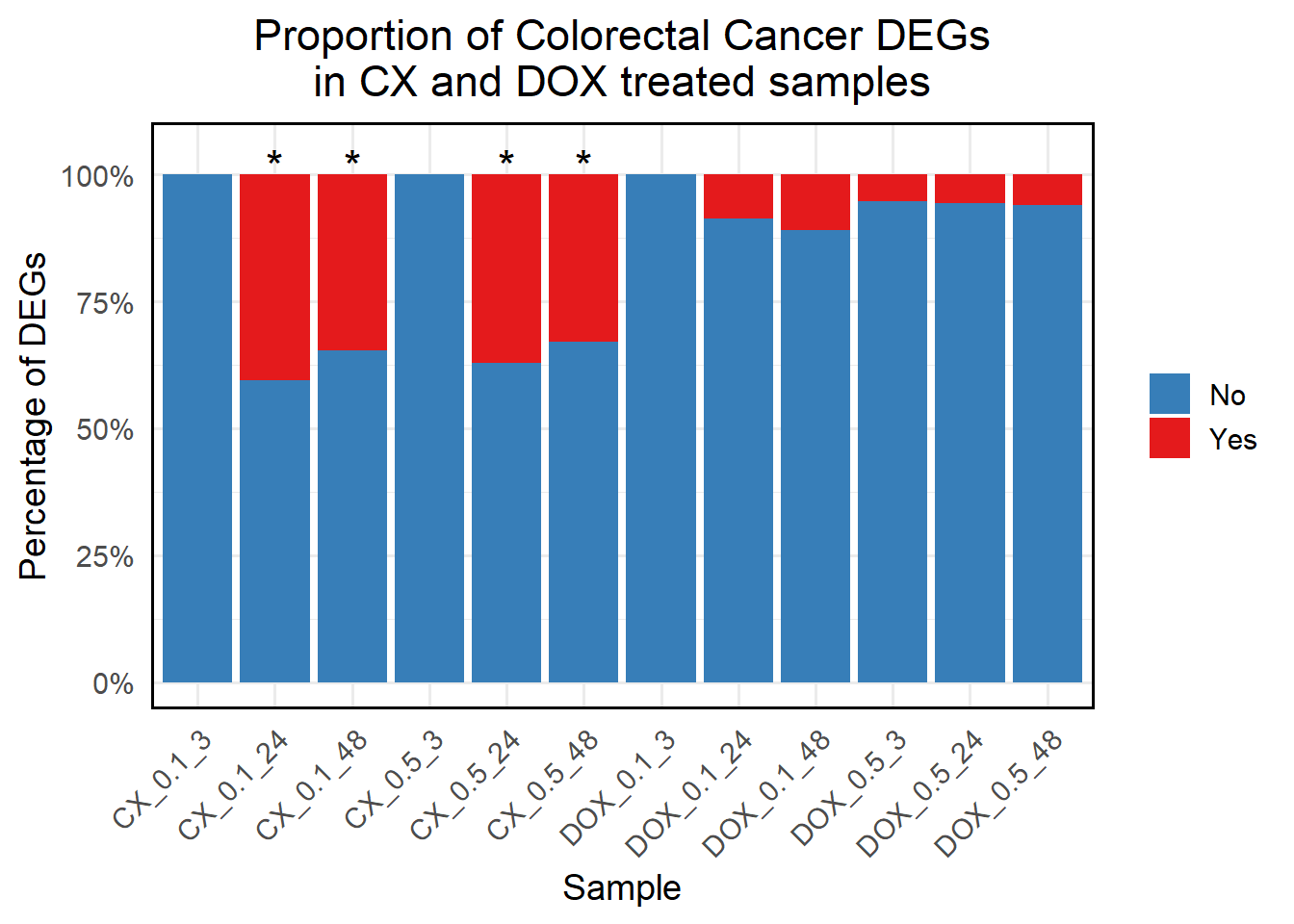
📌 Proportion of Colorectal cancer DE genes in Corrmotif clusters
📌 Load Required Libraries
library(ggplot2)
library(dplyr)
library(tidyr)
library(org.Hs.eg.db)
library(clusterProfiler)Warning: package 'clusterProfiler' was built under R version 4.3.3library(biomaRt)Warning: package 'biomaRt' was built under R version 4.3.2📌 Load Data
# Define correct timepoints
timepoints <- c("6hr", "24hr", "72hr")
# Initialize an empty dataframe to store chi-square results
all_chi_results <- data.frame()
# Loop through each timepoint and perform Chi-square test
for (time in timepoints) {
# Load proportion data for the given timepoint
file_path <- paste0("data/Colorectal/Proportion_data_", time, ".csv")
# Check if the file exists before reading
if (!file.exists(file_path)) {
cat("\n🚨 Warning: File does not exist:", file_path, "\nSkipping this timepoint...\n")
next # Skip this iteration if the file is missing
}
proportion_data <- read.csv(file_path)
# Extract counts for Non-Response group
non_response_counts <- proportion_data %>%
filter(Set == "Non Response") %>%
dplyr::select(DEG, `Non.DEG`) %>%
unlist(use.names = FALSE) # Convert to numeric vector
# Debugging: Print Non-Response counts
cat("\nNon-Response Counts for", time, ":\n")
print(non_response_counts)
# Initialize a list to store chi-square test results for this timepoint
chi_results <- list()
# Perform chi-square test for each response group
for (group in unique(proportion_data$Set)) {
if (group == "Non Response") next # Skip Non Response group
# Extract counts for the current response group
group_counts <- proportion_data %>%
filter(Set == group) %>%
dplyr::select(DEG, `Non.DEG`) %>%
unlist(use.names = FALSE) # Convert to numeric vector
# Ensure valid counts for chi-square test
if (length(group_counts) < 2) group_counts <- c(group_counts, 0)
if (length(non_response_counts) < 2) non_response_counts <- c(non_response_counts, 0)
# Create contingency table
contingency_table <- matrix(c(
group_counts[1], group_counts[2], # Current response group counts
non_response_counts[1], non_response_counts[2] # Non-Response counts
), nrow = 2, byrow = TRUE)
# Debugging: Print contingency table
cat("\nProcessing Group:", group, "at", time, "\n")
cat("Contingency Table:\n")
print(contingency_table)
# Perform chi-square test
test_result <- chisq.test(contingency_table)
p_value <- test_result$p.value
significance <- ifelse(p_value < 0.05, "*", "") # Mark * for p < 0.05
# Store results
chi_results[[group]] <- data.frame(
Set = group,
Timepoint = time,
Chi2 = test_result$statistic,
p_value = p_value,
Significance = significance
)
}
# Combine results for this timepoint into a single dataframe
chi_results <- do.call(rbind, chi_results)
# Append to the overall results dataframe
all_chi_results <- rbind(all_chi_results, chi_results)
}
# Save final chi-square results
write.csv(all_chi_results, "data/Colorectal//Chi_Square_Results_All.csv", row.names = FALSE)📌 Proportion of DE genes across response groups
# Load the saved datasets
prob_all_1 <- read.csv("data/prob_all_1.csv")$Entrez_ID
prob_all_2 <- read.csv("data/prob_all_2.csv")$Entrez_ID
prob_all_3 <- read.csv("data/prob_all_3.csv")$Entrez_ID
prob_all_4 <- read.csv("data/prob_all_4.csv")$Entrez_ID
# Example Response Groups Data (Replace with actual data)
response_groups <- list(
"Non Response" = prob_all_1, # Replace 'prob_all_1', 'prob_all_2', etc. with your actual response group dataframes
"CX_DOX Shared Late Response" = prob_all_2,
"DOX-Specific Response" = prob_all_3,
"Late High Dose DOX-Specific Response" = prob_all_4
)
# Load the proportion data again for visualization
proportion_data <-read.csv("data/Colorectal/Proportion_data.csv")
# Merge chi-square results into proportion data for plotting
proportion_data <- proportion_data %>%
left_join(all_chi_results %>% dplyr::select(Set, Timepoint, Significance), by = c("Set", "Timepoint"))
# Convert to factors for ordered display
proportion_data$Set <- factor(proportion_data$Set, levels = c(
"Non Response",
"CX_DOX Shared Late Response",
"DOX-Specific Response",
"Late High Dose DOX-Specific Response"
))
proportion_data$Timepoint <- factor(proportion_data$Timepoint, levels = timepoints)
# Plot proportions with significance stars
ggplot(proportion_data, aes(x = Set, y = Percentage, fill = Category)) +
geom_bar(stat = "identity", position = "stack") +
facet_wrap(~Timepoint, scales = "fixed") +
scale_fill_manual(values = c("DEG" = "#e41a1c", "Non-DEG" = "#377eb8")) +
geom_text(
data = proportion_data %>% filter(Significance == "*") %>% distinct(Set, Timepoint, Significance),
aes(x = Set, y = 105, label = Significance),
inherit.aes = FALSE,
size = 6,
color = "black",
hjust = 0.5
) +
labs(
title = "Proportion of Colorectal cancer DEGs and Non-DEGs\nAcross Response Groups (6hr, 24hr, 72hr)",
x = "Response Groups",
y = "Percentage",
fill = "Category"
) +
theme_minimal() +
theme(
plot.title = element_text(size = rel(1.5), hjust = 0.5),
axis.title = element_text(size = 15, color = "black"),
axis.text.x = element_text(size = 10, angle = 45, hjust = 1),
legend.title = element_blank(),
panel.border = element_rect(color = "black", fill = NA, size = 1.2),
strip.background = element_blank(),
strip.text = element_text(size = 12, face = "bold")
)Warning: The `size` argument of `element_rect()` is deprecated as of ggplot2 3.4.0.
ℹ Please use the `linewidth` argument instead.
This warning is displayed once every 8 hours.
Call `lifecycle::last_lifecycle_warnings()` to see where this warning was
generated.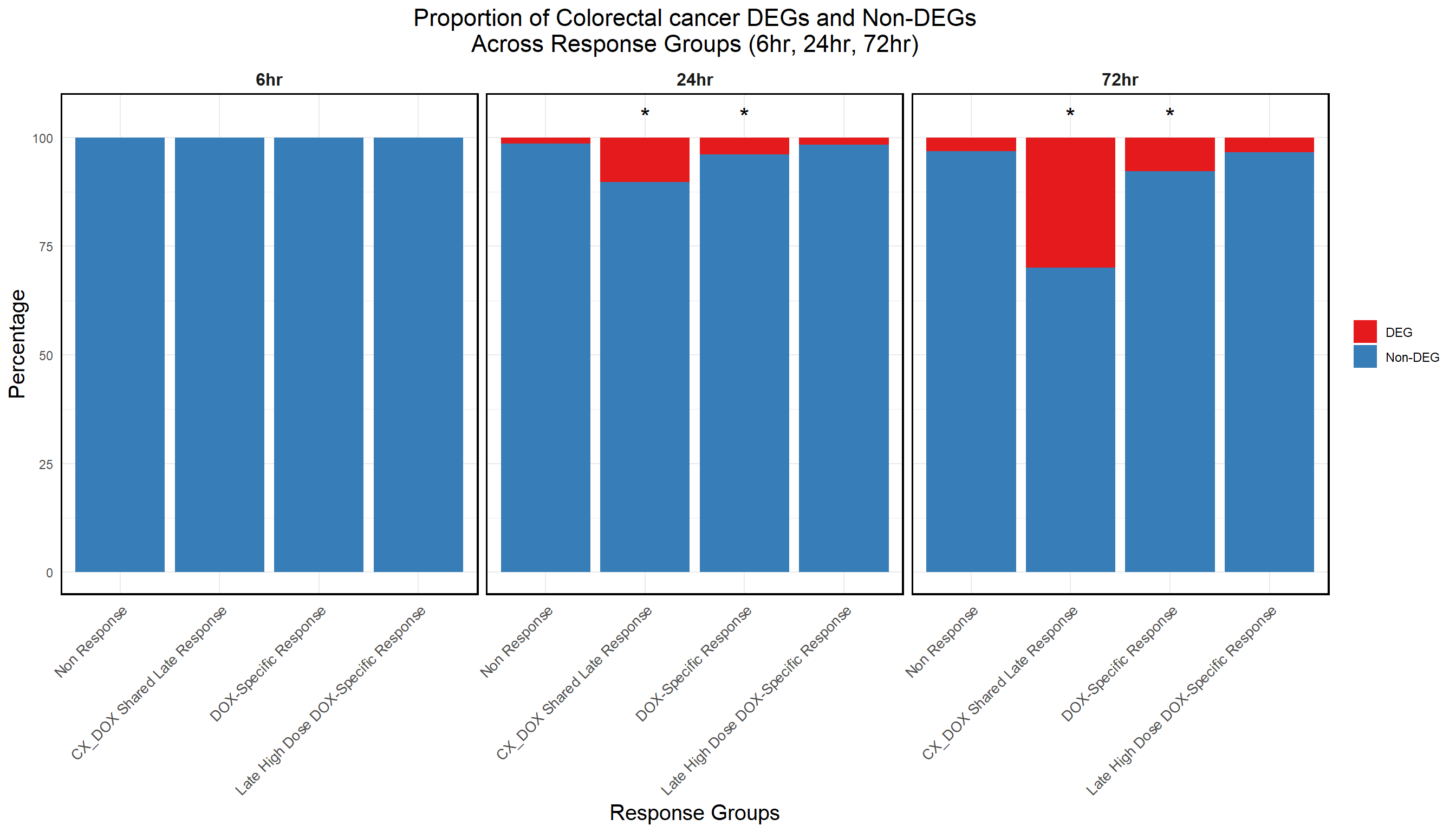
📌 Proportion of CX and DOX DEGs in colorectal cancer genes
📌 Read and Process Data
# Load necessary libraries
library(dplyr)
library(ggplot2)
library(tidyr)
library(org.Hs.eg.db)
# Load DEGs Data
CX_0.1_3 <- read.csv("data/DEGs/Toptable_CX_0.1_3.csv")
CX_0.1_24 <- read.csv("data/DEGs/Toptable_CX_0.1_24.csv")
CX_0.1_48 <- read.csv("data/DEGs/Toptable_CX_0.1_48.csv")
CX_0.5_3 <- read.csv("data/DEGs/Toptable_CX_0.5_3.csv")
CX_0.5_24 <- read.csv("data/DEGs/Toptable_CX_0.5_24.csv")
CX_0.5_48 <- read.csv("data/DEGs/Toptable_CX_0.5_48.csv")
DOX_0.1_3 <- read.csv("data/DEGs/Toptable_DOX_0.1_3.csv")
DOX_0.1_24 <- read.csv("data/DEGs/Toptable_DOX_0.1_24.csv")
DOX_0.1_48 <- read.csv("data/DEGs/Toptable_DOX_0.1_48.csv")
DOX_0.5_3 <- read.csv("data/DEGs/Toptable_DOX_0.5_3.csv")
DOX_0.5_24 <- read.csv("data/DEGs/Toptable_DOX_0.5_24.csv")
DOX_0.5_48 <- read.csv("data/DEGs/Toptable_DOX_0.5_48.csv")
# Extract Significant DEGs
extract_DEGs <- function(df) as.character(df$Entrez_ID[df$adj.P.Val < 0.05])
CX_DEGs <- list(
"CX_0.1_3" = extract_DEGs(CX_0.1_3), "CX_0.1_24" = extract_DEGs(CX_0.1_24), "CX_0.1_48" = extract_DEGs(CX_0.1_48),
"CX_0.5_3" = extract_DEGs(CX_0.5_3), "CX_0.5_24" = extract_DEGs(CX_0.5_24), "CX_0.5_48" = extract_DEGs(CX_0.5_48)
)
DOX_DEGs <- list(
"DOX_0.1_3" = extract_DEGs(DOX_0.1_3), "DOX_0.1_24" = extract_DEGs(DOX_0.1_24), "DOX_0.1_48" = extract_DEGs(DOX_0.1_48),
"DOX_0.5_3" = extract_DEGs(DOX_0.5_3), "DOX_0.5_24" = extract_DEGs(DOX_0.5_24), "DOX_0.5_48" = extract_DEGs(DOX_0.5_48)
)
# Load Colorectal Cancer Gene Lists
data_6hr <- read.csv("data/Colorectal/6hr.csv", stringsAsFactors = FALSE)
data_24hr <- read.csv("data/Colorectal/24hr.csv", stringsAsFactors = FALSE)
data_72hr <- read.csv("data/Colorectal/72hr.csv", stringsAsFactors = FALSE)
# Convert Gene Symbols to Entrez IDs
data_list <- list("6hr" = data_6hr, "24hr" = data_24hr, "72hr" = data_72hr)
data_list <- lapply(data_list, function(df) {
df %>% mutate(Entrez_ID = mapIds(org.Hs.eg.db, keys = Symbol, column = "ENTREZID", keytype = "SYMBOL", multiVals = "first")) %>% na.omit()
})
lit_genes <- lapply(data_list, function(df) df$Entrez_ID)
# Function to calculate DEGs proportion in Colorectal Cancer dataset
calculate_proportion <- function(deg_list, drug_name, cancer_genes, timepoint) {
data.frame(
Sample = names(deg_list),
Drug = drug_name,
Timepoint = timepoint,
DEGs_in_Cancer = sapply(deg_list, function(ids) sum(ids %in% cancer_genes)),
Non_DEGs_in_Cancer = length(cancer_genes) - sapply(deg_list, function(ids) sum(ids %in% cancer_genes))
) %>%
mutate(
Yes_Proportion = (DEGs_in_Cancer / length(cancer_genes)) * 100,
No_Proportion = (Non_DEGs_in_Cancer / length(cancer_genes)) * 100
)
}
# Calculate Proportions for Each Timepoint
proportion_data <- bind_rows(
lapply(names(lit_genes), function(tp) calculate_proportion(CX_DEGs, "CX-5461", lit_genes[[tp]], tp)),
lapply(names(lit_genes), function(tp) calculate_proportion(DOX_DEGs, "DOX", lit_genes[[tp]], tp))
)
# Convert Data to Long Format for Faceting
proportion_long <- proportion_data %>%
pivot_longer(cols = c(Yes_Proportion, No_Proportion), names_to = "Category", values_to = "Percentage") %>%
mutate(Category = ifelse(Category == "Yes_Proportion", "Yes", "No"))
# Ensure Correct Ordering
sample_order <- c(
"CX_0.1_3", "CX_0.1_24", "CX_0.1_48", "CX_0.5_3", "CX_0.5_24", "CX_0.5_48",
"DOX_0.1_3", "DOX_0.1_24", "DOX_0.1_48", "DOX_0.5_3", "DOX_0.5_24", "DOX_0.5_48"
)
proportion_long$Sample <- factor(proportion_long$Sample, levels = sample_order)
proportion_long$Timepoint <- factor(proportion_long$Timepoint, levels = c("6hr", "24hr", "72hr"))
proportion_long$Category <- factor(proportion_long$Category, levels = c("Yes", "No"))
# Generate Stacked Bar Plot with Faceting
ggplot(proportion_long, aes(x = Sample, y = Percentage, fill = Category)) +
geom_bar(stat = "identity", position = "stack") +
facet_wrap(~Timepoint, scales = "fixed") +
scale_y_continuous(labels = scales::percent_format(scale = 1), limits = c(0, 100)) +
scale_fill_manual(values = c("Yes" = "#e41a1c", "No" = "#377eb8")) +
labs(
title = "Proportion of CX-5461 and DOX DEGs in Colorectal Cancer Dataset",
x = "Samples",
y = "Percentage",
fill = "Category"
) +
theme_minimal() +
theme(
plot.title = element_text(size = rel(1.5), hjust = 0.5),
axis.text.x = element_text(size = 10, angle = 45, hjust = 1),
legend.title = element_blank(),
panel.border = element_rect(color = "black", fill = NA, linewidth = 1.2),
strip.background = element_blank(),
strip.text = element_text(size = 12, face = "bold")
)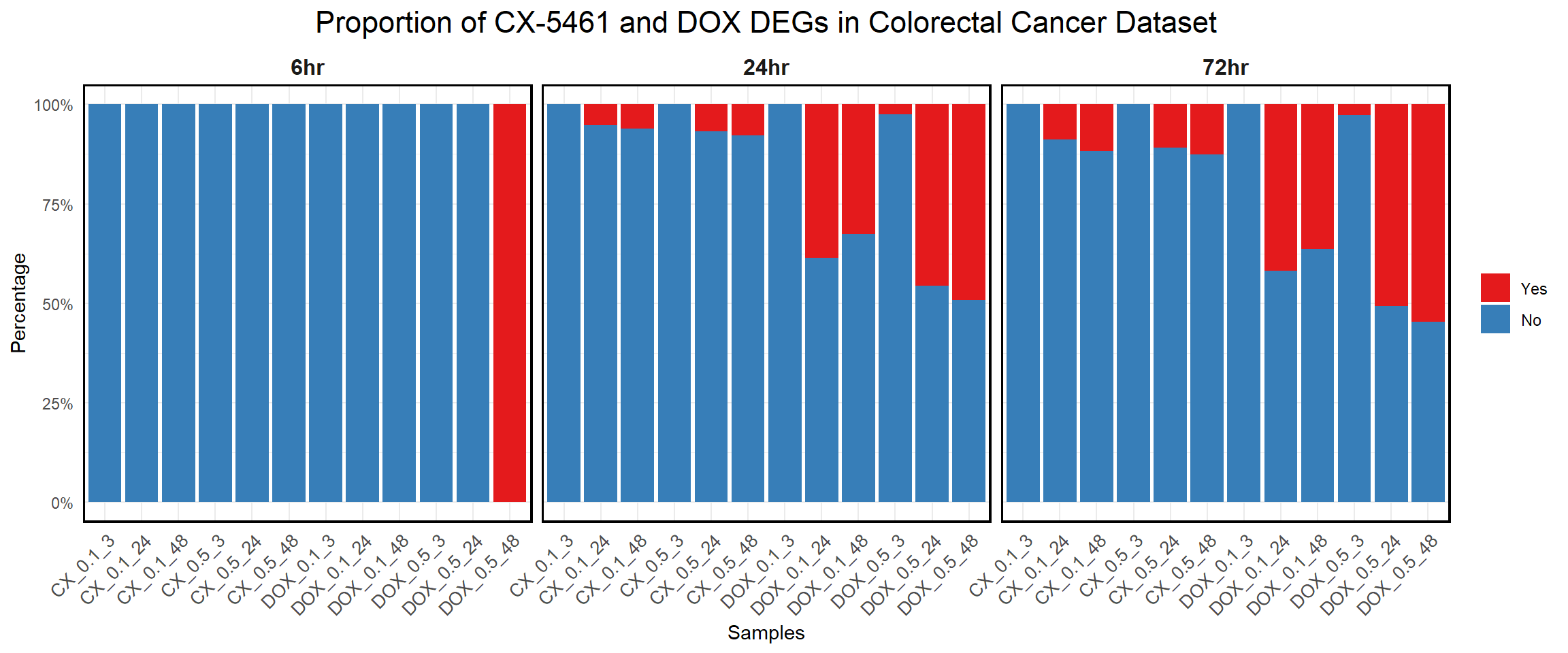
📌 Correlation of colorectal cancer genes with CX and DOX expressed genes
📌 6hr
# Import the CSV file
data_6hr_logFC <- read.csv("data/Colorectal/6hrlogFC.csv", stringsAsFactors = FALSE)
# Map gene symbols to Entrez IDs using org.Hs.eg.db
data_6hr_logFC <- data_6hr_logFC %>%
mutate(Entrez_ID = mapIds(org.Hs.eg.db,
keys = Symbol,
column = "ENTREZID",
keytype = "SYMBOL",
multiVals = "first"))
# Merge datasets on Entrez_ID for CX and DOX at both concentrations (3 hours)
merged_CX_0.1 <- merge(data_6hr_logFC, CX_0.1_3, by = "Entrez_ID")
merged_CX_0.5 <- merge(data_6hr_logFC, CX_0.5_3, by = "Entrez_ID")
merged_DOX_0.1 <- merge(data_6hr_logFC, DOX_0.1_3, by = "Entrez_ID")
merged_DOX_0.5 <- merge(data_6hr_logFC, DOX_0.5_3, by = "Entrez_ID")
# Remove NA values
merged_CX_0.1 <- na.omit(merged_CX_0.1)
merged_CX_0.5 <- na.omit(merged_CX_0.5)
merged_DOX_0.1 <- na.omit(merged_DOX_0.1)
merged_DOX_0.5 <- na.omit(merged_DOX_0.5)
# Rename columns explicitly to avoid conflicts
colnames(merged_CX_0.1) <- colnames(merged_CX_0.5) <-
colnames(merged_DOX_0.1) <- colnames(merged_DOX_0.5) <-
c("Entrez_ID", "Symbol_6hr", "logFC_6hr", "logFC_Drug", "AveExpr_Drug", "t_Drug", "P.Value_Drug", "adj.P.Val_Drug", "B_Drug")
# Add drug and concentration labels for faceting
merged_CX_0.1$Drug <- "CX (3hr)"
merged_CX_0.5$Drug <- "CX (3hr)"
merged_DOX_0.1$Drug <- "DOX (3hr)"
merged_DOX_0.5$Drug <- "DOX (3hr)"
merged_CX_0.1$Concentration <- "0.1 µM"
merged_CX_0.5$Concentration <- "0.5 µM"
merged_DOX_0.1$Concentration <- "0.1 µM"
merged_DOX_0.5$Concentration <- "0.5 µM"
# Combine all datasets into a single data frame
merged_data <- rbind(
merged_CX_0.1[, c("Entrez_ID", "logFC_Drug", "logFC_6hr", "Concentration", "Drug")],
merged_CX_0.5[, c("Entrez_ID", "logFC_Drug", "logFC_6hr", "Concentration", "Drug")],
merged_DOX_0.1[, c("Entrez_ID", "logFC_Drug", "logFC_6hr", "Concentration", "Drug")],
merged_DOX_0.5[, c("Entrez_ID", "logFC_Drug", "logFC_6hr", "Concentration", "Drug")]
)
# Calculate correlations for each facet
cor_CX_0.1 <- cor.test(merged_CX_0.1$logFC_Drug, merged_CX_0.1$logFC_6hr, method = "pearson")
cor_CX_0.5 <- cor.test(merged_CX_0.5$logFC_Drug, merged_CX_0.5$logFC_6hr, method = "pearson")
cor_DOX_0.1 <- cor.test(merged_DOX_0.1$logFC_Drug, merged_DOX_0.1$logFC_6hr, method = "pearson")
cor_DOX_0.5 <- cor.test(merged_DOX_0.5$logFC_Drug, merged_DOX_0.5$logFC_6hr, method = "pearson")
# Data frame for r and p-values annotations
correlation_data <- data.frame(
Drug = rep(c("CX (3hr)", "DOX (3hr)"), each = 2),
Concentration = rep(c("0.1 µM", "0.5 µM"), times = 2),
x = max(merged_data$logFC_Drug, na.rm = TRUE) * 0.75, # Adjusted placement for better fit
y = max(merged_data$logFC_6hr, na.rm = TRUE) * 0.85,
label = c(
paste0("r = ", round(cor_CX_0.1$estimate, 3), "\np = ", signif(cor_CX_0.1$p.value, 3)),
paste0("r = ", round(cor_CX_0.5$estimate, 3), "\np = ", signif(cor_CX_0.5$p.value, 3)),
paste0("r = ", round(cor_DOX_0.1$estimate, 3), "\np = ", signif(cor_DOX_0.1$p.value, 3)),
paste0("r = ", round(cor_DOX_0.5$estimate, 3), "\np = ", signif(cor_DOX_0.5$p.value, 3))
)
)
# Create scatter plot with facets for concentration (vertically) and drug (horizontally)
scatter_plot <- ggplot(merged_data, aes(x = logFC_Drug, y = logFC_6hr)) +
geom_point(alpha = 0.6, color = "black") + # Black scatter points
geom_smooth(method = "lm", color = "black", se = FALSE) + # Black regression line
labs(
title = "Correlation between Drug (3hr) and Colorectal 6hr logFC",
x = "logFC (Drug_3hr)",
y = "logFC (Colorectal 6hr)"
) +
theme_minimal() +
theme(
plot.title = element_text(size = 14, face = "bold"),
# Outer box around the entire facet plot
panel.border = element_rect(color = "black", fill = NA, linewidth = 2),
# Black box around each facet title
strip.background = element_rect(fill = "white", color = "black", linewidth = 1.5),
strip.text = element_text(size = 12, face = "bold", color = "black")
) +
# Facet by drug (horizontally) and concentration (vertically)
facet_grid(Concentration ~ Drug) +
# Add r and p-value in the upper-right corner of each facet with better fitting font size
geom_text(data = correlation_data,
aes(x = x, y = y, label = label),
inherit.aes = FALSE, size = 3, fontface = "bold") # Reduced font size for better fit
# Display plot
print(scatter_plot)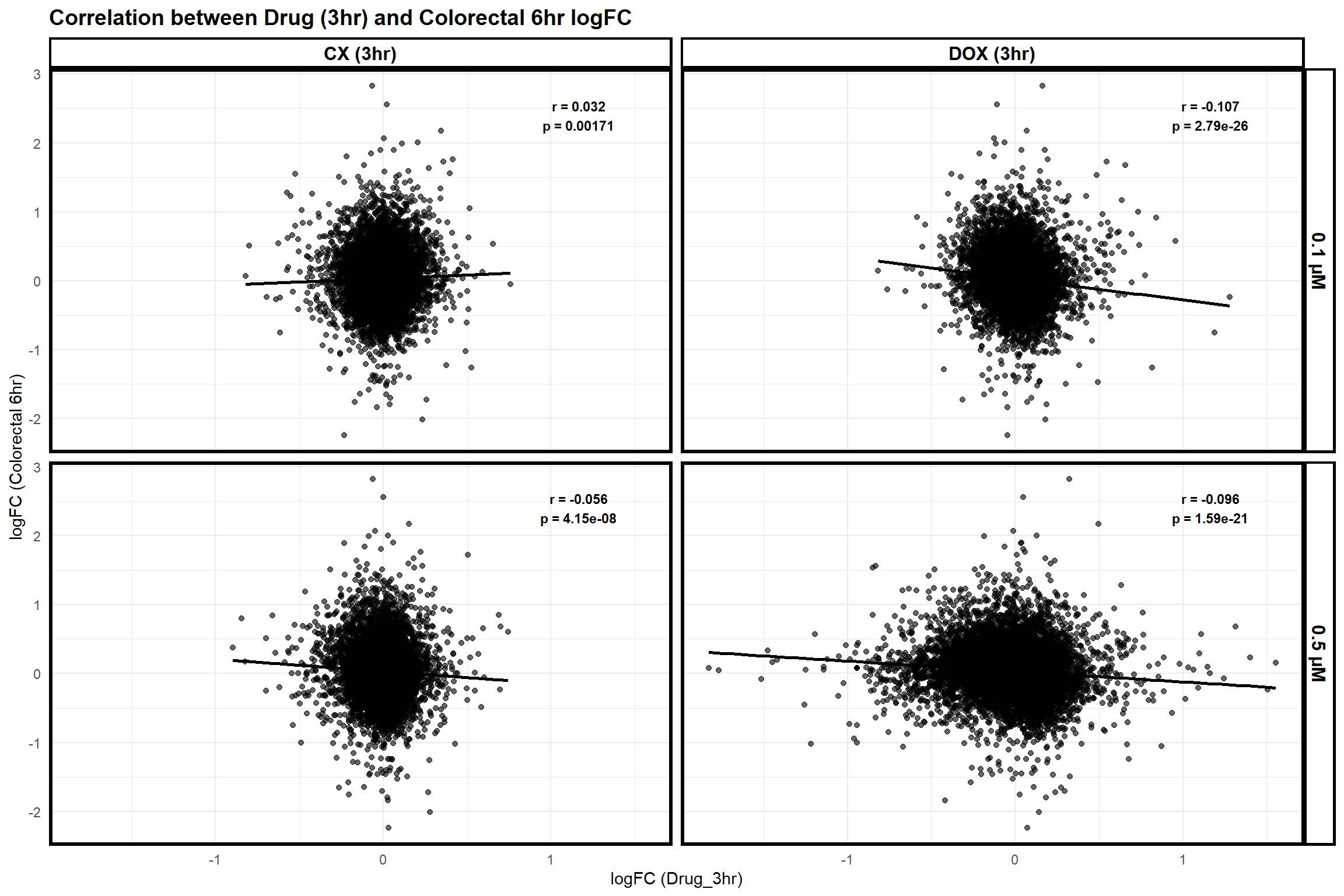
📌 24hr
# Import the CSV file
data_24hr_logFC <- read.csv("data/Colorectal/24hrlogFC.csv", stringsAsFactors = FALSE)
# Map gene symbols to Entrez IDs using org.Hs.eg.db
data_24hr_logFC <- data_24hr_logFC %>%
mutate(Entrez_ID = mapIds(org.Hs.eg.db,
keys = Symbol,
column = "ENTREZID",
keytype = "SYMBOL",
multiVals = "first"))
# Merge datasets on Entrez_ID for CX and DOX at both concentrations (24 hours)
merged_CX_0.1_24 <- merge(data_24hr_logFC, CX_0.1_24, by = "Entrez_ID")
merged_CX_0.5_24 <- merge(data_24hr_logFC, CX_0.5_24, by = "Entrez_ID")
merged_DOX_0.1_24 <- merge(data_24hr_logFC, DOX_0.1_24, by = "Entrez_ID")
merged_DOX_0.5_24 <- merge(data_24hr_logFC, DOX_0.5_24, by = "Entrez_ID")
# Remove NA values
merged_CX_0.1_24 <- na.omit(merged_CX_0.1_24)
merged_CX_0.5_24 <- na.omit(merged_CX_0.5_24)
merged_DOX_0.1_24 <- na.omit(merged_DOX_0.1_24)
merged_DOX_0.5_24 <- na.omit(merged_DOX_0.5_24)
# Rename columns explicitly to avoid conflicts
colnames(merged_CX_0.1_24) <- colnames(merged_CX_0.5_24) <-
colnames(merged_DOX_0.1_24) <- colnames(merged_DOX_0.5_24) <-
c("Entrez_ID", "Symbol_24hr", "logFC_24hr", "logFC_Drug", "AveExpr_Drug", "t_Drug", "P.Value_Drug", "adj.P.Val_Drug", "B_Drug")
# Add drug and concentration labels for faceting
merged_CX_0.1_24$Drug <- "CX (24hr)"
merged_CX_0.5_24$Drug <- "CX (24hr)"
merged_DOX_0.1_24$Drug <- "DOX (24hr)"
merged_DOX_0.5_24$Drug <- "DOX (24hr)"
merged_CX_0.1_24$Concentration <- "0.1 µM"
merged_CX_0.5_24$Concentration <- "0.5 µM"
merged_DOX_0.1_24$Concentration <- "0.1 µM"
merged_DOX_0.5_24$Concentration <- "0.5 µM"
# Combine all datasets into a single data frame
merged_data_24hr <- rbind(
merged_CX_0.1_24[, c("Entrez_ID", "logFC_Drug", "logFC_24hr", "Concentration", "Drug")],
merged_CX_0.5_24[, c("Entrez_ID", "logFC_Drug", "logFC_24hr", "Concentration", "Drug")],
merged_DOX_0.1_24[, c("Entrez_ID", "logFC_Drug", "logFC_24hr", "Concentration", "Drug")],
merged_DOX_0.5_24[, c("Entrez_ID", "logFC_Drug", "logFC_24hr", "Concentration", "Drug")]
)
# Calculate correlations for each facet
cor_CX_0.1_24 <- cor.test(merged_CX_0.1_24$logFC_Drug, merged_CX_0.1_24$logFC_24hr, method = "pearson")
cor_CX_0.5_24 <- cor.test(merged_CX_0.5_24$logFC_Drug, merged_CX_0.5_24$logFC_24hr, method = "pearson")
cor_DOX_0.1_24 <- cor.test(merged_DOX_0.1_24$logFC_Drug, merged_DOX_0.1_24$logFC_24hr, method = "pearson")
cor_DOX_0.5_24 <- cor.test(merged_DOX_0.5_24$logFC_Drug, merged_DOX_0.5_24$logFC_24hr, method = "pearson")
# Data frame for r and p-values annotations
correlation_data_24hr <- data.frame(
Drug = rep(c("CX (24hr)", "DOX (24hr)"), each = 2),
Concentration = rep(c("0.1 µM", "0.5 µM"), times = 2),
x = max(merged_data_24hr$logFC_Drug, na.rm = TRUE) * 0.75, # Adjusted placement for better fit
y = max(merged_data_24hr$logFC_24hr, na.rm = TRUE) * 0.85,
label = c(
paste0("r = ", round(cor_CX_0.1_24$estimate, 3), "\np = ", signif(cor_CX_0.1_24$p.value, 3)),
paste0("r = ", round(cor_CX_0.5_24$estimate, 3), "\np = ", signif(cor_CX_0.5_24$p.value, 3)),
paste0("r = ", round(cor_DOX_0.1_24$estimate, 3), "\np = ", signif(cor_DOX_0.1_24$p.value, 3)),
paste0("r = ", round(cor_DOX_0.5_24$estimate, 3), "\np = ", signif(cor_DOX_0.5_24$p.value, 3))
)
)
# Create scatter plot with facets for concentration (vertically) and drug (horizontally)
scatter_plot_24hr <- ggplot(merged_data_24hr, aes(x = logFC_Drug, y = logFC_24hr)) +
geom_point(alpha = 0.6, color = "black") + # Black scatter points
geom_smooth(method = "lm", color = "black", se = FALSE) + # Black regression line
labs(
title = "Correlation between Drug (24hr) and Colorectal 24hr logFC",
x = "logFC (Drug_24hr)",
y = "logFC (Colorectal 24hr)"
) +
theme_minimal() +
theme(
plot.title = element_text(size = 14, face = "bold"),
# Outer box around the entire facet plot
panel.border = element_rect(color = "black", fill = NA, linewidth = 2),
# Black box around each facet title
strip.background = element_rect(fill = "white", color = "black", linewidth = 1.5),
strip.text = element_text(size = 12, face = "bold", color = "black")
) +
# Facet by drug (horizontally) and concentration (vertically)
facet_grid(Concentration ~ Drug) +
# Add r and p-value in the upper-right corner of each facet with better fitting font size
geom_text(data = correlation_data_24hr,
aes(x = x, y = y, label = label),
inherit.aes = FALSE, size = 3, fontface = "bold") # Reduced font size for better fit
# Display plot
print(scatter_plot_24hr)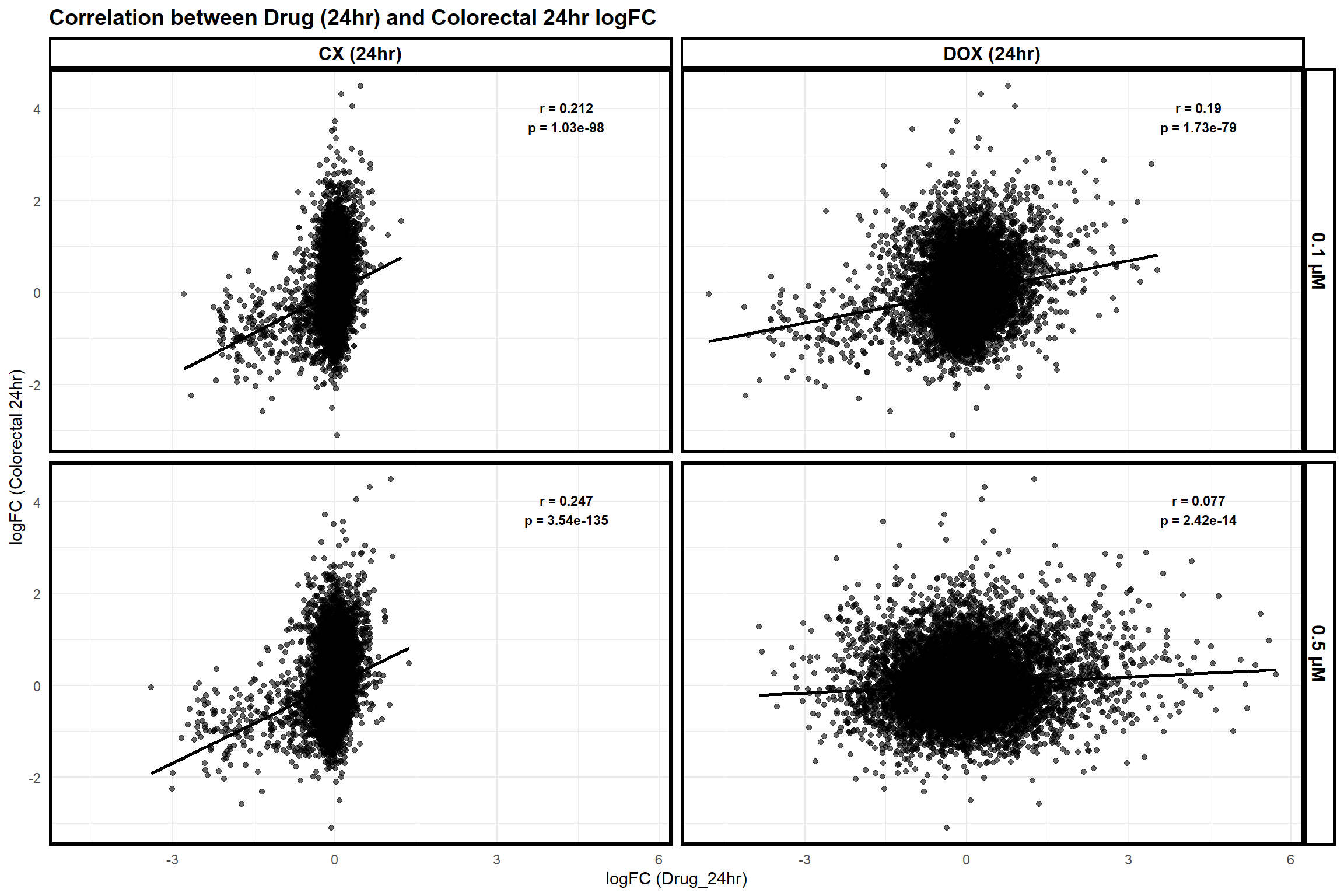
📌 72hr
# Import the CSV file
data_72hr_logFC <- read.csv("data/Colorectal/72hrlogFC.csv", stringsAsFactors = FALSE)
# Map gene symbols to Entrez IDs using org.Hs.eg.db
data_72hr_logFC <- data_72hr_logFC %>%
mutate(Entrez_ID = mapIds(org.Hs.eg.db,
keys = Symbol,
column = "ENTREZID",
keytype = "SYMBOL",
multiVals = "first"))
# Merge datasets on Entrez_ID for CX and DOX at both concentrations (48 hours)
merged_CX_0.1_48 <- merge(data_72hr_logFC, CX_0.1_48, by = "Entrez_ID")
merged_CX_0.5_48 <- merge(data_72hr_logFC, CX_0.5_48, by = "Entrez_ID")
merged_DOX_0.1_48 <- merge(data_72hr_logFC, DOX_0.1_48, by = "Entrez_ID")
merged_DOX_0.5_48 <- merge(data_72hr_logFC, DOX_0.5_48, by = "Entrez_ID")
# Remove NA values
merged_CX_0.1_48 <- na.omit(merged_CX_0.1_48)
merged_CX_0.5_48 <- na.omit(merged_CX_0.5_48)
merged_DOX_0.1_48 <- na.omit(merged_DOX_0.1_48)
merged_DOX_0.5_48 <- na.omit(merged_DOX_0.5_48)
# Rename columns explicitly to avoid conflicts
colnames(merged_CX_0.1_48) <- colnames(merged_CX_0.5_48) <-
colnames(merged_DOX_0.1_48) <- colnames(merged_DOX_0.5_48) <-
c("Entrez_ID", "Symbol_72hr", "logFC_72hr", "logFC_Drug", "AveExpr_Drug", "t_Drug", "P.Value_Drug", "adj.P.Val_Drug", "B_Drug")
# Add drug and concentration labels for faceting
merged_CX_0.1_48$Drug <- "CX (48hr)"
merged_CX_0.5_48$Drug <- "CX (48hr)"
merged_DOX_0.1_48$Drug <- "DOX (48hr)"
merged_DOX_0.5_48$Drug <- "DOX (48hr)"
merged_CX_0.1_48$Concentration <- "0.1 µM"
merged_CX_0.5_48$Concentration <- "0.5 µM"
merged_DOX_0.1_48$Concentration <- "0.1 µM"
merged_DOX_0.5_48$Concentration <- "0.5 µM"
# Combine all datasets into a single data frame
merged_data_48hr <- rbind(
merged_CX_0.1_48[, c("Entrez_ID", "logFC_Drug", "logFC_72hr", "Concentration", "Drug")],
merged_CX_0.5_48[, c("Entrez_ID", "logFC_Drug", "logFC_72hr", "Concentration", "Drug")],
merged_DOX_0.1_48[, c("Entrez_ID", "logFC_Drug", "logFC_72hr", "Concentration", "Drug")],
merged_DOX_0.5_48[, c("Entrez_ID", "logFC_Drug", "logFC_72hr", "Concentration", "Drug")]
)
# Calculate correlations for each facet
cor_CX_0.1_48 <- cor.test(merged_CX_0.1_48$logFC_Drug, merged_CX_0.1_48$logFC_72hr, method = "pearson")
cor_CX_0.5_48 <- cor.test(merged_CX_0.5_48$logFC_Drug, merged_CX_0.5_48$logFC_72hr, method = "pearson")
cor_DOX_0.1_48 <- cor.test(merged_DOX_0.1_48$logFC_Drug, merged_DOX_0.1_48$logFC_72hr, method = "pearson")
cor_DOX_0.5_48 <- cor.test(merged_DOX_0.5_48$logFC_Drug, merged_DOX_0.5_48$logFC_72hr, method = "pearson")
# Data frame for r and p-values annotations
correlation_data_48hr <- data.frame(
Drug = rep(c("CX (48hr)", "DOX (48hr)"), each = 2),
Concentration = rep(c("0.1 µM", "0.5 µM"), times = 2),
x = max(merged_data_48hr$logFC_Drug, na.rm = TRUE) * 0.75, # Adjusted placement for better fit
y = max(merged_data_48hr$logFC_72hr, na.rm = TRUE) * 0.85,
label = c(
paste0("r = ", round(cor_CX_0.1_48$estimate, 3), "\np = ", signif(cor_CX_0.1_48$p.value, 3)),
paste0("r = ", round(cor_CX_0.5_48$estimate, 3), "\np = ", signif(cor_CX_0.5_48$p.value, 3)),
paste0("r = ", round(cor_DOX_0.1_48$estimate, 3), "\np = ", signif(cor_DOX_0.1_48$p.value, 3)),
paste0("r = ", round(cor_DOX_0.5_48$estimate, 3), "\np = ", signif(cor_DOX_0.5_48$p.value, 3))
)
)
# Create scatter plot with facets for concentration (vertically) and drug (horizontally)
scatter_plot_48hr <- ggplot(merged_data_48hr, aes(x = logFC_Drug, y = logFC_72hr)) +
geom_point(alpha = 0.6, color = "black") + # Black scatter points
geom_smooth(method = "lm", color = "black", se = FALSE) + # Black regression line
labs(
title = "Correlation between Drug (48hr) and Colorectal 72hr logFC",
x = "logFC (Drug_48hr)",
y = "logFC (Colorectal 72hr)"
) +
theme_minimal() +
theme(
plot.title = element_text(size = 14, face = "bold"),
# Outer box around the entire facet plot
panel.border = element_rect(color = "black", fill = NA, linewidth = 2),
# Black box around each facet title
strip.background = element_rect(fill = "white", color = "black", linewidth = 1.5),
strip.text = element_text(size = 12, face = "bold", color = "black")
) +
# Facet by drug (horizontally) and concentration (vertically)
facet_grid(Concentration ~ Drug) +
# Add r and p-value in the upper-right corner of each facet with better fitting font size
geom_text(data = correlation_data_48hr,
aes(x = x, y = y, label = label),
inherit.aes = FALSE, size = 3, fontface = "bold") # Reduced font size for better fit
# Display plot
print(scatter_plot_48hr)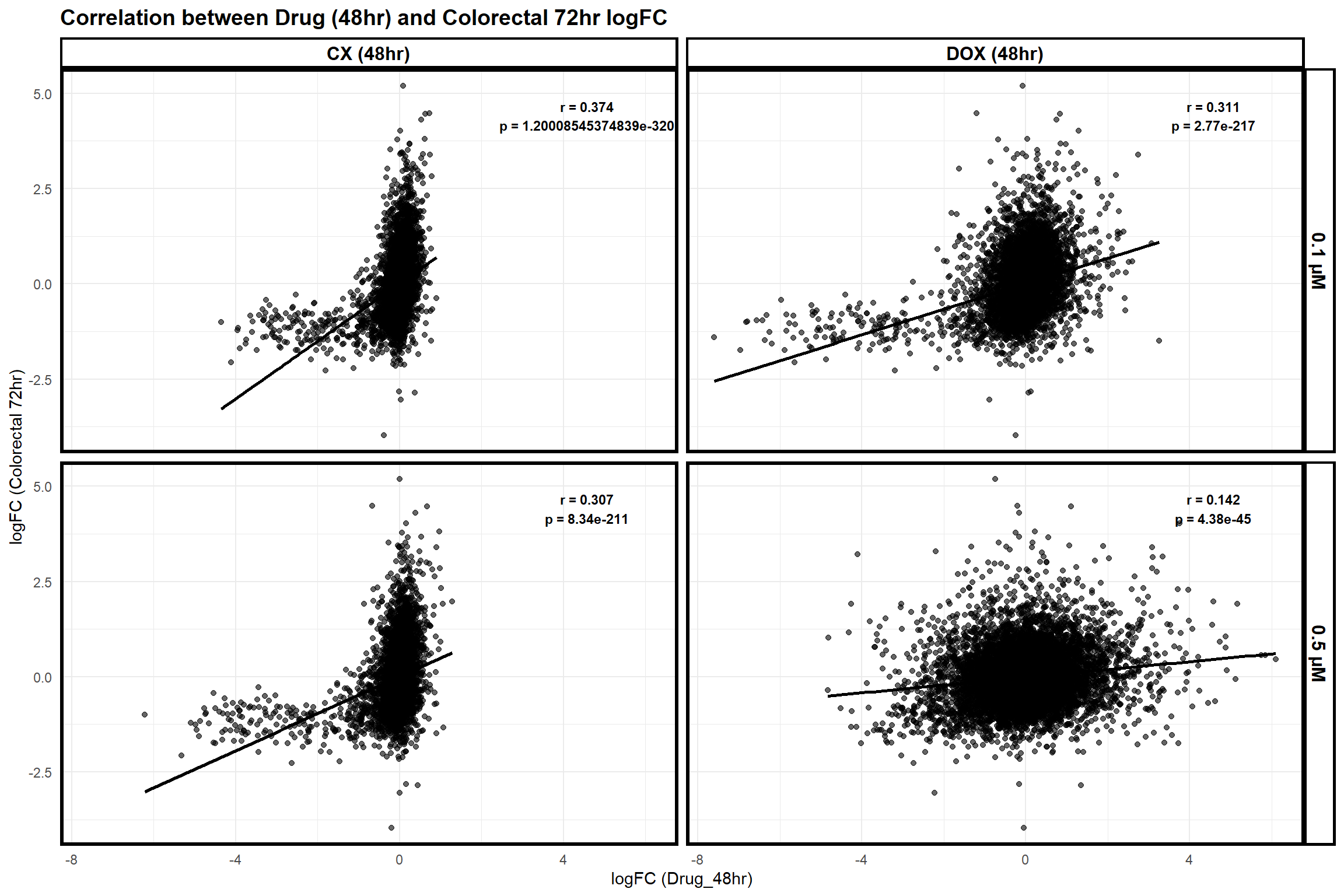
📌 Proportion of Colorectal cancer Genes in corrmotif 0.1 micromolar
# Load necessary libraries
library(dplyr)
library(ggplot2)
library(tidyr)
library(org.Hs.eg.db)
# Load Colorectal Cancer Gene Lists
data_6hr <- read.csv("data/Colorectal/6hr.csv", stringsAsFactors = FALSE)
data_24hr <- read.csv("data/Colorectal/24hr.csv", stringsAsFactors = FALSE)
data_72hr <- read.csv("data/Colorectal/72hr.csv", stringsAsFactors = FALSE)
# Convert Gene Symbols to Entrez IDs
data_list <- list("6hr" = data_6hr, "24hr" = data_24hr, "72hr" = data_72hr)
data_list <- lapply(data_list, function(df) {
df %>% mutate(Entrez_ID = mapIds(org.Hs.eg.db, keys = Symbol, column = "ENTREZID", keytype = "SYMBOL", multiVals = "first")) %>% na.omit()
})
lit_genes <- lapply(data_list, function(df) df$Entrez_ID)
# Load Corrmotif Groups for 0.1 Concentration
prob_groups_0.1 <- list(
"Non Response (0.1)" = read.csv("data/prob_1_0.1.csv")$Entrez_ID,
"CX_DOX mid-late (0.1)" = read.csv("data/prob_2_0.1.csv")$Entrez_ID,
"DOX only mid-late (0.1)"= read.csv("data/prob_3_0.1.csv")$Entrez_ID
)
# Function to calculate proportions in colorectal cancer dataset
calculate_proportion <- function(deg_list, group_name, cancer_genes, timepoint) {
total_group_genes <- length(deg_list)
matched_genes <- sum(deg_list %in% cancer_genes)
data.frame(
Group = group_name,
Timepoint = timepoint,
Colorectal_DEGs = matched_genes,
Non_Colorectal_DEGs = total_group_genes - matched_genes
) %>%
mutate(
Yes_Proportion = (Colorectal_DEGs / total_group_genes) * 100,
No_Proportion = (Non_Colorectal_DEGs / total_group_genes) * 100
)
}
# Calculate Proportions for Each Timepoint
proportion_data <- bind_rows(
lapply(names(lit_genes), function(tp) calculate_proportion(prob_groups_0.1[["Non Response (0.1)"]], "Non Response (0.1)", lit_genes[[tp]], tp)),
lapply(names(lit_genes), function(tp) calculate_proportion(prob_groups_0.1[["CX_DOX mid-late (0.1)"]], "CX_DOX mid-late (0.1)", lit_genes[[tp]], tp)),
lapply(names(lit_genes), function(tp) calculate_proportion(prob_groups_0.1[["DOX only mid-late (0.1)"]], "DOX only mid-late (0.1)", lit_genes[[tp]], tp)))
# Convert Data to Long Format for Faceting
proportion_long <- proportion_data %>%
pivot_longer(cols = c(Yes_Proportion, No_Proportion), names_to = "Category", values_to = "Percentage") %>%
mutate(Category = ifelse(Category == "Yes_Proportion", "Yes", "No"))
# Perform Chi-Square Test Comparing Groups to Non-Response
test_results <- data.frame(Group = character(), Timepoint = character(), P_Value = numeric())
target_groups <- c("CX_DOX mid-late (0.1)", "DOX only mid-late (0.1)")
for (tp in names(lit_genes)) {
for (grp in target_groups) {
contingency_table <- matrix(
c(
sum(prob_groups_0.1[[grp]] %in% lit_genes[[tp]]),
length(prob_groups_0.1[[grp]]) - sum(prob_groups_0.1[[grp]] %in% lit_genes[[tp]]),
sum(prob_groups_0.1[["Non Response (0.1)"]] %in% lit_genes[[tp]]),
length(prob_groups_0.1[["Non Response (0.1)"]]) - sum(prob_groups_0.1[["Non Response (0.1)"]] %in% lit_genes[[tp]])
),
nrow = 2, byrow = TRUE
)
test_result <- chisq.test(contingency_table)
test_results <- rbind(test_results, data.frame(Group = grp, Timepoint = tp, P_Value = test_result$p.value))
}
}Warning in chisq.test(contingency_table): Chi-squared approximation may be
incorrect
Warning in chisq.test(contingency_table): Chi-squared approximation may be
incorrect# Add Significance Stars
test_results$Significant <- ifelse(test_results$P_Value < 0.05, "*", "")
proportion_long <- left_join(proportion_long, test_results, by = c("Group", "Timepoint"))
# Ensure Correct Ordering
proportion_long$Group <- factor(proportion_long$Group, levels = c("Non Response (0.1)", "CX_DOX mid-late (0.1)", "DOX only mid-late (0.1)"))
proportion_long$Timepoint <- factor(proportion_long$Timepoint, levels = c("6hr", "24hr", "72hr"))
proportion_long$Category <- factor(proportion_long$Category, levels = c("Yes", "No"))
# Generate Stacked Bar Plot with Faceting and Significance Annotations
ggplot(proportion_long, aes(x = Group, y = Percentage, fill = Category)) +
geom_bar(stat = "identity", position = "stack") +
facet_wrap(~Timepoint, scales = "fixed") +
geom_text(data = subset(proportion_long, Significant == "*"),
aes(x = Group, y = 102, label = "*"),
size = 6, color = "black", fontface = "bold") +
scale_y_continuous(labels = scales::percent_format(scale = 1), limits = c(0, 105)) +
scale_fill_manual(values = c("Yes" = "#e41a1c", "No" = "#377eb8")) +
labs(
title = "Proportion of Colorectal cancer Genes in\n0.1 Corrmotif Response Groups",
x = "Group",
y = "Percentage",
fill = "Category"
) +
theme_minimal() +
theme(
plot.title = element_text(size = rel(1.5), hjust = 0.5),
axis.text.x = element_text(size = 10, angle = 45, hjust = 1),
legend.title = element_blank(),
panel.border = element_rect(color = "black", fill = NA, linewidth = 1.2),
strip.background = element_blank(),
strip.text = element_text(size = 12, face = "bold")
)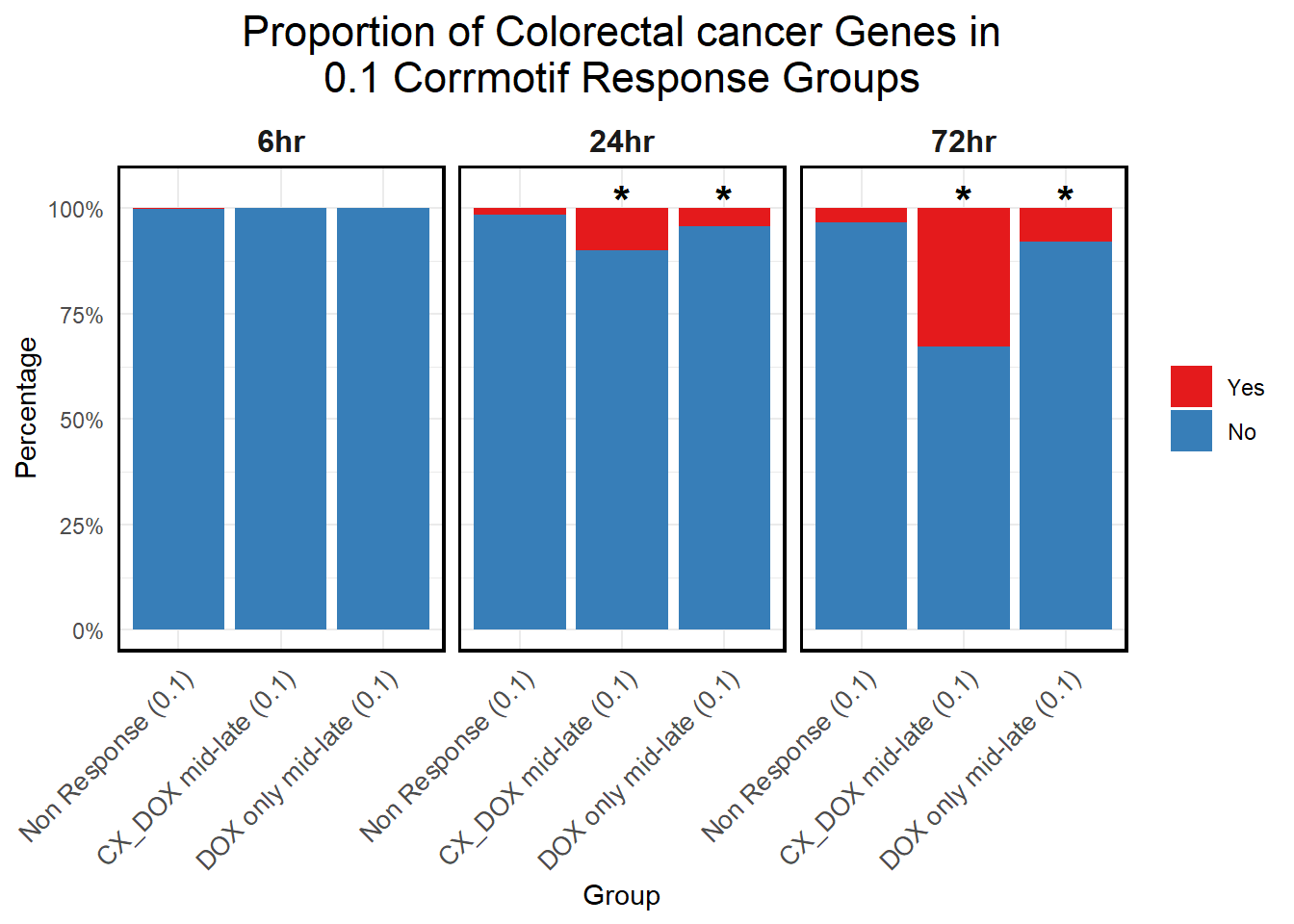
📌 Proportion of Colorectal cancer Genes in corrmotif 0.5 micromolar
# Load necessary libraries
library(dplyr)
library(ggplot2)
library(tidyr)
library(org.Hs.eg.db)
# Load Colorectal Cancer Gene Lists
data_6hr <- read.csv("data/Colorectal/6hr.csv", stringsAsFactors = FALSE)
data_24hr <- read.csv("data/Colorectal/24hr.csv", stringsAsFactors = FALSE)
data_72hr <- read.csv("data/Colorectal/72hr.csv", stringsAsFactors = FALSE)
# Convert Gene Symbols to Entrez IDs
data_list <- list("6hr" = data_6hr, "24hr" = data_24hr, "72hr" = data_72hr)
data_list <- lapply(data_list, function(df) {
df %>% mutate(Entrez_ID = mapIds(org.Hs.eg.db, keys = Symbol, column = "ENTREZID", keytype = "SYMBOL", multiVals = "first")) %>% na.omit()
})
lit_genes <- lapply(data_list, function(df) df$Entrez_ID)
# Load Corrmotif Groups for 0.5 Concentration
prob_groups_0.5 <- list(
"Non Response (0.5)" = read.csv("data/prob_1_0.5.csv")$Entrez_ID,
"DOX-specific response (0.5)" = read.csv("data/prob_2_0.5.csv")$Entrez_ID,
"DOX only mid-late response (0.5)" = read.csv("data/prob_3_0.5.csv")$Entrez_ID,
"CX DOX (early) response (0.5)" = read.csv("data/prob_4_0.5.csv")$Entrez_ID,
"DOX + CX (mid-late) response (0.5)" = read.csv("data/prob_5_0.5.csv")$Entrez_ID
)
# Function to calculate proportions in colorectal cancer dataset
calculate_proportion <- function(deg_list, group_name, cancer_genes, timepoint) {
total_group_genes <- length(deg_list)
matched_genes <- sum(deg_list %in% cancer_genes)
data.frame(
Group = group_name,
Timepoint = timepoint,
Colorectal_DEGs = matched_genes,
Non_Colorectal_DEGs = total_group_genes - matched_genes
) %>%
mutate(
Yes_Proportion = (Colorectal_DEGs / total_group_genes) * 100,
No_Proportion = (Non_Colorectal_DEGs / total_group_genes) * 100
)
}
# Calculate Proportions for Each Timepoint
proportion_data <- bind_rows(
lapply(names(lit_genes), function(tp) calculate_proportion(prob_groups_0.5[["Non Response (0.5)"]], "Non Response (0.5)", lit_genes[[tp]], tp)),
lapply(names(lit_genes), function(tp) calculate_proportion(prob_groups_0.5[["DOX-specific response (0.5)"]], "DOX-specific response (0.5)", lit_genes[[tp]], tp)),
lapply(names(lit_genes), function(tp) calculate_proportion(prob_groups_0.5[["DOX only mid-late response (0.5)"]], "DOX only mid-late response (0.5)", lit_genes[[tp]], tp)),
lapply(names(lit_genes), function(tp) calculate_proportion(prob_groups_0.5[["CX DOX (early) response (0.5)"]], "CX DOX (early) response (0.5)", lit_genes[[tp]], tp)),
lapply(names(lit_genes), function(tp) calculate_proportion(prob_groups_0.5[["DOX + CX (mid-late) response (0.5)"]], "DOX + CX (mid-late) response (0.5)", lit_genes[[tp]], tp))
)
# Convert Data to Long Format for Faceting
proportion_long <- proportion_data %>%
pivot_longer(cols = c(Yes_Proportion, No_Proportion), names_to = "Category", values_to = "Percentage") %>%
mutate(Category = ifelse(Category == "Yes_Proportion", "Yes", "No"))
# Perform Chi-Square Test Comparing Groups to Non-Response
test_results <- data.frame(Group = character(), Timepoint = character(), P_Value = numeric())
target_groups <- c("DOX-specific response (0.5)", "DOX only mid-late response (0.5)", "CX DOX (early) response (0.5)", "DOX + CX (mid-late) response (0.5)")
for (tp in names(lit_genes)) {
for (grp in target_groups) {
contingency_table <- matrix(
c(
sum(prob_groups_0.5[[grp]] %in% lit_genes[[tp]]),
length(prob_groups_0.5[[grp]]) - sum(prob_groups_0.5[[grp]] %in% lit_genes[[tp]]),
sum(prob_groups_0.5[["Non Response (0.5)"]] %in% lit_genes[[tp]]),
length(prob_groups_0.5[["Non Response (0.5)"]]) - sum(prob_groups_0.5[["Non Response (0.5)"]] %in% lit_genes[[tp]])
),
nrow = 2, byrow = TRUE
)
test_result <- chisq.test(contingency_table)
test_results <- rbind(test_results, data.frame(Group = grp, Timepoint = tp, P_Value = test_result$p.value))
}
}Warning in chisq.test(contingency_table): Chi-squared approximation may be
incorrect
Warning in chisq.test(contingency_table): Chi-squared approximation may be
incorrect
Warning in chisq.test(contingency_table): Chi-squared approximation may be
incorrect
Warning in chisq.test(contingency_table): Chi-squared approximation may be
incorrect
Warning in chisq.test(contingency_table): Chi-squared approximation may be
incorrect
Warning in chisq.test(contingency_table): Chi-squared approximation may be
incorrect
Warning in chisq.test(contingency_table): Chi-squared approximation may be
incorrect# Add Significance Stars
test_results$Significant <- ifelse(test_results$P_Value < 0.05, "*", "")
proportion_long <- left_join(proportion_long, test_results, by = c("Group", "Timepoint"))
# Ensure Correct Ordering
proportion_long$Group <- factor(proportion_long$Group, levels = c("Non Response (0.5)", "DOX-specific response (0.5)", "DOX only mid-late response (0.5)", "CX DOX (early) response (0.5)", "DOX + CX (mid-late) response (0.5)"))
proportion_long$Timepoint <- factor(proportion_long$Timepoint, levels = c("6hr", "24hr", "72hr"))
proportion_long$Category <- factor(proportion_long$Category, levels = c("Yes", "No"))
# Generate Stacked Bar Plot with Faceting and Significance Annotations
ggplot(proportion_long, aes(x = Group, y = Percentage, fill = Category)) +
geom_bar(stat = "identity", position = "stack") +
facet_wrap(~Timepoint, scales = "fixed") +
geom_text(data = subset(proportion_long, Significant == "*"),
aes(x = Group, y = 102, label = "*"),
size = 6, color = "black", fontface = "bold") +
scale_y_continuous(labels = scales::percent_format(scale = 1), limits = c(0, 105)) +
scale_fill_manual(values = c("Yes" = "#e41a1c", "No" = "#377eb8")) +
labs(
title = "Proportion of Colorectal cancer Genes in\n0.5 Corrmotif Response Groups",
x = "Group",
y = "Percentage",
fill = "Category"
) +
theme_minimal() +
theme(
plot.title = element_text(size = rel(1.5), hjust = 0.5),
axis.text.x = element_text(size = 10, angle = 45, hjust = 1),
legend.title = element_blank(),
panel.border = element_rect(color = "black", fill = NA, linewidth = 1.2),
strip.background = element_blank(),
strip.text = element_text(size = 12, face = "bold")
)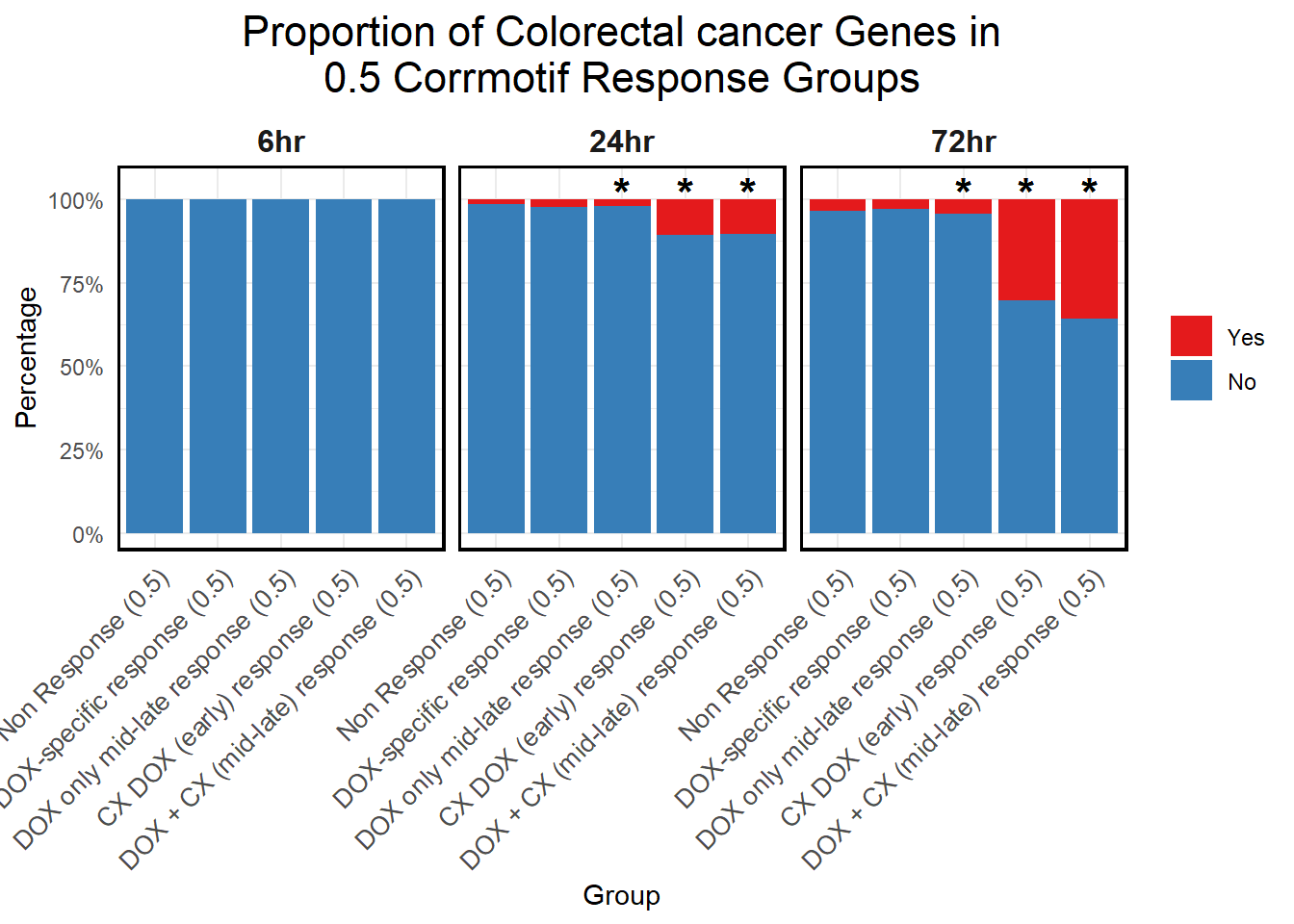
📌 Correlation heatmap
# Load necessary libraries
library(ggplot2)
library(reshape2)
library(dplyr)
library(org.Hs.eg.db)
library(biomaRt)
# Load colorectal cancer logFC data for 6hr, 24hr, and 72hr
data_6hr_logFC <- read.csv("data/Colorectal/6hrlogFC.csv", stringsAsFactors = FALSE)
data_24hr_logFC <- read.csv("data/Colorectal/24hrlogFC.csv", stringsAsFactors = FALSE)
data_72hr_logFC <- read.csv("data/Colorectal/72hrlogFC.csv", stringsAsFactors = FALSE)
# Map gene symbols to Entrez IDs
map_entrez <- function(data) {
data %>%
mutate(Entrez_ID = mapIds(org.Hs.eg.db,
keys = Symbol,
column = "ENTREZID",
keytype = "SYMBOL",
multiVals = "first"))
}
data_6hr_logFC <- map_entrez(data_6hr_logFC)
data_24hr_logFC <- map_entrez(data_24hr_logFC)
data_72hr_logFC <- map_entrez(data_72hr_logFC)
# Load CX-5461 and DOX logFC data for 3hr, 24hr, 48hr
CX_0.1_3 <- read.csv("data/DEGs/Toptable_CX_0.1_3.csv", stringsAsFactors = FALSE)
CX_0.5_3 <- read.csv("data/DEGs/Toptable_CX_0.5_3.csv", stringsAsFactors = FALSE)
CX_0.1_24 <- read.csv("data/DEGs/Toptable_CX_0.1_24.csv", stringsAsFactors = FALSE)
CX_0.5_24 <- read.csv("data/DEGs/Toptable_CX_0.5_24.csv", stringsAsFactors = FALSE)
CX_0.1_48 <- read.csv("data/DEGs/Toptable_CX_0.1_48.csv", stringsAsFactors = FALSE)
CX_0.5_48 <- read.csv("data/DEGs/Toptable_CX_0.5_48.csv", stringsAsFactors = FALSE)
DOX_0.1_3 <- read.csv("data/DEGs/Toptable_DOX_0.1_3.csv", stringsAsFactors = FALSE)
DOX_0.5_3 <- read.csv("data/DEGs/Toptable_DOX_0.5_3.csv", stringsAsFactors = FALSE)
DOX_0.1_24 <- read.csv("data/DEGs/Toptable_DOX_0.1_24.csv", stringsAsFactors = FALSE)
DOX_0.5_24 <- read.csv("data/DEGs/Toptable_DOX_0.5_24.csv", stringsAsFactors = FALSE)
DOX_0.1_48 <- read.csv("data/DEGs/Toptable_DOX_0.1_48.csv", stringsAsFactors = FALSE)
DOX_0.5_48 <- read.csv("data/DEGs/Toptable_DOX_0.5_48.csv", stringsAsFactors = FALSE)
# Function to merge colorectal and drug datasets
merge_data <- function(colorectal_data, drug_data) {
merged <- merge(colorectal_data, drug_data, by = "Entrez_ID")
na.omit(merged) # Remove NA values
}
# Merge data for all timepoints and concentrations
merged_CX_0.1_3 <- merge_data(data_6hr_logFC, CX_0.1_3)
merged_CX_0.5_3 <- merge_data(data_6hr_logFC, CX_0.5_3)
merged_DOX_0.1_3 <- merge_data(data_6hr_logFC, DOX_0.1_3)
merged_DOX_0.5_3 <- merge_data(data_6hr_logFC, DOX_0.5_3)
merged_CX_0.1_24 <- merge_data(data_24hr_logFC, CX_0.1_24)
merged_CX_0.5_24 <- merge_data(data_24hr_logFC, CX_0.5_24)
merged_DOX_0.1_24 <- merge_data(data_24hr_logFC, DOX_0.1_24)
merged_DOX_0.5_24 <- merge_data(data_24hr_logFC, DOX_0.5_24)
merged_CX_0.1_48 <- merge_data(data_72hr_logFC, CX_0.1_48)
merged_CX_0.5_48 <- merge_data(data_72hr_logFC, CX_0.5_48)
merged_DOX_0.1_48 <- merge_data(data_72hr_logFC, DOX_0.1_48)
merged_DOX_0.5_48 <- merge_data(data_72hr_logFC, DOX_0.5_48)
# Compute correlation coefficients (Pearson)
compute_correlation <- function(df) {
cor.test(df$logFC.x, df$logFC.y, method = "pearson")$estimate
}
cor_CX_0.1_3 <- compute_correlation(merged_CX_0.1_3)
cor_CX_0.5_3 <- compute_correlation(merged_CX_0.5_3)
cor_DOX_0.1_3 <- compute_correlation(merged_DOX_0.1_3)
cor_DOX_0.5_3 <- compute_correlation(merged_DOX_0.5_3)
cor_CX_0.1_24 <- compute_correlation(merged_CX_0.1_24)
cor_CX_0.5_24 <- compute_correlation(merged_CX_0.5_24)
cor_DOX_0.1_24 <- compute_correlation(merged_DOX_0.1_24)
cor_DOX_0.5_24 <- compute_correlation(merged_DOX_0.5_24)
cor_CX_0.1_48 <- compute_correlation(merged_CX_0.1_48)
cor_CX_0.5_48 <- compute_correlation(merged_CX_0.5_48)
cor_DOX_0.1_48 <- compute_correlation(merged_DOX_0.1_48)
cor_DOX_0.5_48 <- compute_correlation(merged_DOX_0.5_48)
# Define correlation values from previously computed Pearson correlations
correlation_data <- data.frame(
Sample = c("CX_0.1_3", "CX_0.5_3", "DOX_0.1_3", "DOX_0.5_3",
"CX_0.1_24", "CX_0.5_24", "DOX_0.1_24", "DOX_0.5_24",
"CX_0.1_48", "CX_0.5_48", "DOX_0.1_48", "DOX_0.5_48"),
Correlation = c(
cor_CX_0.1_3, cor_CX_0.5_3, cor_DOX_0.1_3, cor_DOX_0.5_3,
cor_CX_0.1_24, cor_CX_0.5_24, cor_DOX_0.1_24, cor_DOX_0.5_24,
cor_CX_0.1_48, cor_CX_0.5_48, cor_DOX_0.1_48, cor_DOX_0.5_48
)
)
# Add a single column category for labeling
correlation_data$Comparison <- "Colorectal"
# Convert to long format for ggplot
heatmap_data_long <- melt(correlation_data, id.vars = c("Sample", "Comparison"))
# Ensure the Y-axis follows the correct top-down ordering
heatmap_data_long$Sample <- factor(heatmap_data_long$Sample, levels = rev(c( # Reversed order
"CX_0.1_3", "CX_0.5_3", "DOX_0.1_3", "DOX_0.5_3",
"CX_0.1_24", "CX_0.5_24", "DOX_0.1_24", "DOX_0.5_24",
"CX_0.1_48", "CX_0.5_48", "DOX_0.1_48", "DOX_0.5_48"
)))
# Create the correctly ordered single-column heatmap
ggplot(heatmap_data_long, aes(x = Comparison, y = Sample, fill = value)) +
geom_tile(color = "white") +
scale_fill_gradient2(
low = "blue", mid = "white", high = "red", limits = c(-0.4,0.4)) + # Updated scale
geom_text(aes(label = round(value, 3)), color = "black", size = 5, fontface = "bold") +
labs(
x = "", y = "Samples", fill = "Correlation (r)",
title = "Correlation in the drug response\nbetween each drug in iPSC-CMs and\nthe response to CX-5461 in colorectal cancer cells"
) +
theme_minimal() +
theme(
axis.text.x = element_text(face = "bold", size = 14),
axis.text.y = element_text(face = "bold", size = 12),
axis.title.y = element_text(face = "bold", size = 14),
plot.title = element_text(face = "bold", hjust = 0.5, size = 16),
legend.title = element_text(face = "bold"),
panel.grid = element_blank()
)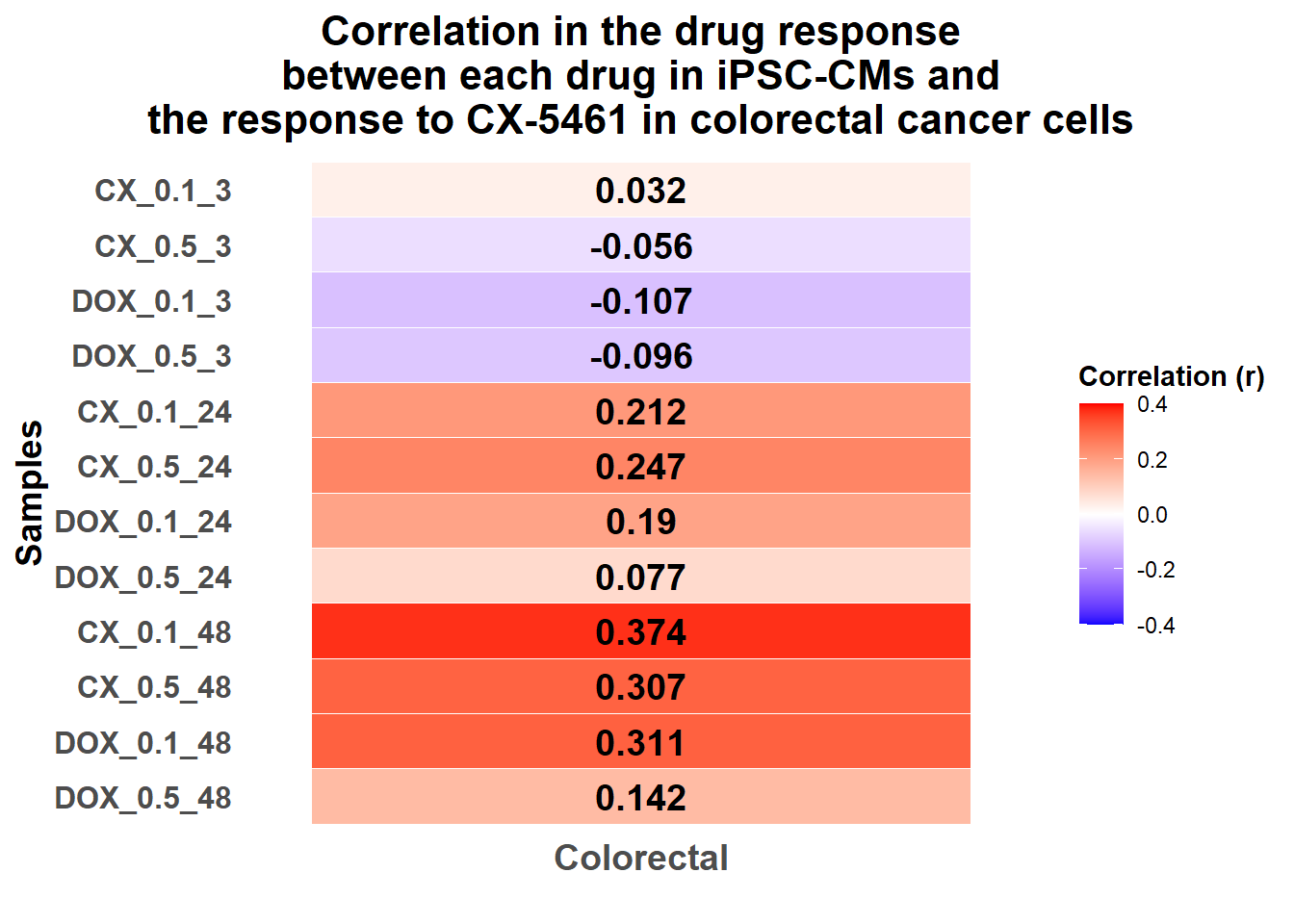
📌 logFC Correlation heatmap (Complete dataset)
# 📦 Load Required Libraries
library(data.table)Warning: package 'data.table' was built under R version 4.3.3library(tidyverse)
library(janitor)Warning: package 'janitor' was built under R version 4.3.3library(org.Hs.eg.db)
library(AnnotationDbi)
library(ComplexHeatmap)Warning: package 'ComplexHeatmap' was built under R version 4.3.1library(circlize)Warning: package 'circlize' was built under R version 4.3.3library(RColorBrewer)
library(grid)
# 🧠 Function to map gene SYMBOL to Entrez ID for colorectal datasets
map_entrez <- function(df) {
df %>%
mutate(entrez_id = mapIds(
org.Hs.eg.db,
keys = Symbol,
column = "ENTREZID",
keytype = "SYMBOL",
multiVals = "first"
)) %>%
mutate(entrez_id = as.character(entrez_id))
}
# 📁 Define All logFC Input Files (CX-5461, DOX, Colorectal)
logfc_files <- list(
"CX_0.1_3" = "data/DEGs/Toptable_CX_0.1_3.csv",
"CX_0.1_24" = "data/DEGs/Toptable_CX_0.1_24.csv",
"CX_0.1_48" = "data/DEGs/Toptable_CX_0.1_48.csv",
"CX_0.5_3" = "data/DEGs/Toptable_CX_0.5_3.csv",
"CX_0.5_24" = "data/DEGs/Toptable_CX_0.5_24.csv",
"CX_0.5_48" = "data/DEGs/Toptable_CX_0.5_48.csv",
"DOX_0.1_3" = "data/DEGs/Toptable_DOX_0.1_3.csv",
"DOX_0.1_24" = "data/DEGs/Toptable_DOX_0.1_24.csv",
"DOX_0.1_48" = "data/DEGs/Toptable_DOX_0.1_48.csv",
"DOX_0.5_3" = "data/DEGs/Toptable_DOX_0.5_3.csv",
"DOX_0.5_24" = "data/DEGs/Toptable_DOX_0.5_24.csv",
"DOX_0.5_48" = "data/DEGs/Toptable_DOX_0.5_48.csv",
"Colorectal_6hr" = "data/Colorectal/6hrlogFC.csv",
"Colorectal_24hr" = "data/Colorectal/24hrlogFC.csv",
"Colorectal_72hr" = "data/Colorectal/72hrlogFC.csv"
)
# 🔁 Process All Files: Extract clean (Entrez_ID, logFC) tibble per sample
logfc_list <- map2(names(logfc_files), logfc_files, function(name, path) {
df <- fread(path, data.table = FALSE) %>% as_tibble()
# Map Entrez ID for colorectal
if (grepl("colorectal", tolower(name))) {
df <- map_entrez(df)
}
# Auto-detect columns
logfc_col <- names(df)[str_detect(names(df), regex("^logfc$", ignore_case = TRUE))][1]
entrez_col <- names(df)[str_detect(names(df), regex("entrez.*id", ignore_case = TRUE))][1]
if (is.na(logfc_col) || is.na(entrez_col)) {
stop(paste("Missing columns in:", name,
"\nAvailable columns:", paste(names(df), collapse = ", ")))
}
df %>%
filter(!is.na(.data[[logfc_col]]), !is.na(.data[[entrez_col]])) %>%
mutate(entrez_id = as.character(.data[[entrez_col]])) %>%
distinct(entrez_id, .keep_all = TRUE) %>%
dplyr::select(entrez_id, logFC = all_of(logfc_col)) %>%
dplyr::rename(!!name := logFC)
})
# 🧬 Identify Common Entrez_IDs Across All Datasets
common_ids <- purrr::reduce(logfc_list, inner_join, by = "entrez_id") %>%
pull(entrez_id) %>%
unique()
# 🧱 Build Final logFC Matrix (Entrez_ID × Sample)
logfc_matrix <- map(logfc_list, ~ filter(.x, entrez_id %in% common_ids)) %>%
purrr::reduce(inner_join, by = "entrez_id") %>%
column_to_rownames("entrez_id") %>%
as.matrix()
# ✅ Assume logfc_matrix is already created
# Rows = Entrez_IDs, Columns = Samples
sample_names <- colnames(logfc_matrix)
# 📁 Create Metadata Inline
metadata <- tibble(Sample = sample_names) %>%
mutate(
Drug = case_when(
str_detect(Sample, "CX") ~ "CX-5461",
str_detect(Sample, "DOX") ~ "DOX",
str_detect(Sample, "Colorectal") ~ "CX-5461"
),
Tissue = case_when(
str_detect(Sample, "Colorectal") ~ "Colorectal",
TRUE ~ "Cardiomyocyte"
),
Time = case_when(
str_detect(Sample, "6hr") ~ "6",
str_detect(Sample, "24") ~ "24",
str_detect(Sample, "72") ~ "72",
str_detect(Sample, "48") ~ "48",
str_detect(Sample, "3") ~ "3",
TRUE ~ NA_character_
),
Conc = case_when(
str_detect(Sample, "Colorectal") ~ "0.5",
str_detect(Sample, "0.1") ~ "0.1",
str_detect(Sample, "0.5") ~ "0.5",
TRUE ~ NA_character_
)
)
metadata <- metadata %>%
mutate(Time = factor(Time, levels = c("3", "6", "24", "48", "72")))
# 🎨 Define Annotation Colors
time_colors <- c("3" = "purple", "6" = "blue", "24" = "pink", "48" = "tomato3", "72" = "orange")
drug_colors <- c("CX-5461" = "gold", "DOX" = "magenta4")
conc_colors <- c("0.1" = "lightblue", "0.5" = "lightcoral")
tissue_colors <- c("Cardiomyocyte" = "forestgreen", "Colorectal" = "steelblue")
# 🔝 Top Annotation Track
top_annot <- HeatmapAnnotation(
Tissue = metadata$Tissue,
Drug = metadata$Drug,
Timepoint = metadata$Time,
Concentration = metadata$Conc,
col = list(
Tissue = tissue_colors,
Drug = drug_colors,
Timepoint = time_colors,
Concentration = conc_colors
),
annotation_legend_param = list(
Tissue = list(title = "Tissue"),
Drug = list(title = "Drug"),
Timepoint = list(title = "Timepoint (hr)"),
Concentration = list(title = "Conc (µM)")
)
)
# 📊 Compute Pearson Correlation Matrix
pearson_matrix <- cor(logfc_matrix, method = "pearson")
# 🎨 Color Function for Pearson r
col_fun <- colorRamp2(c(-1, 0, 1), c("blue", "white", "red"))
# 🔥 Draw Pearson Correlation Heatmap
Heatmap(
pearson_matrix,
name = "Pearson\nCorrelation",
col = col_fun,
top_annotation = top_annot,
cluster_rows = TRUE,
cluster_columns = TRUE,
row_names_gp = gpar(fontsize = 9),
column_names_gp = gpar(fontsize = 9),
column_names_rot = 45,
rect_gp = gpar(col = "white", lwd = 0.5),
cell_fun = function(j, i, x, y, w, h, fill) {
grid.text(sprintf("%.2f", pearson_matrix[i, j]), x, y, gp = gpar(fontsize = 6.5))
},
heatmap_legend_param = list(
title = "Correlation",
at = c(-1, -0.5, 0, 0.5, 1),
labels = c("-1", "-0.5", "0", "0.5", "1"),
direction = "vertical"
)
)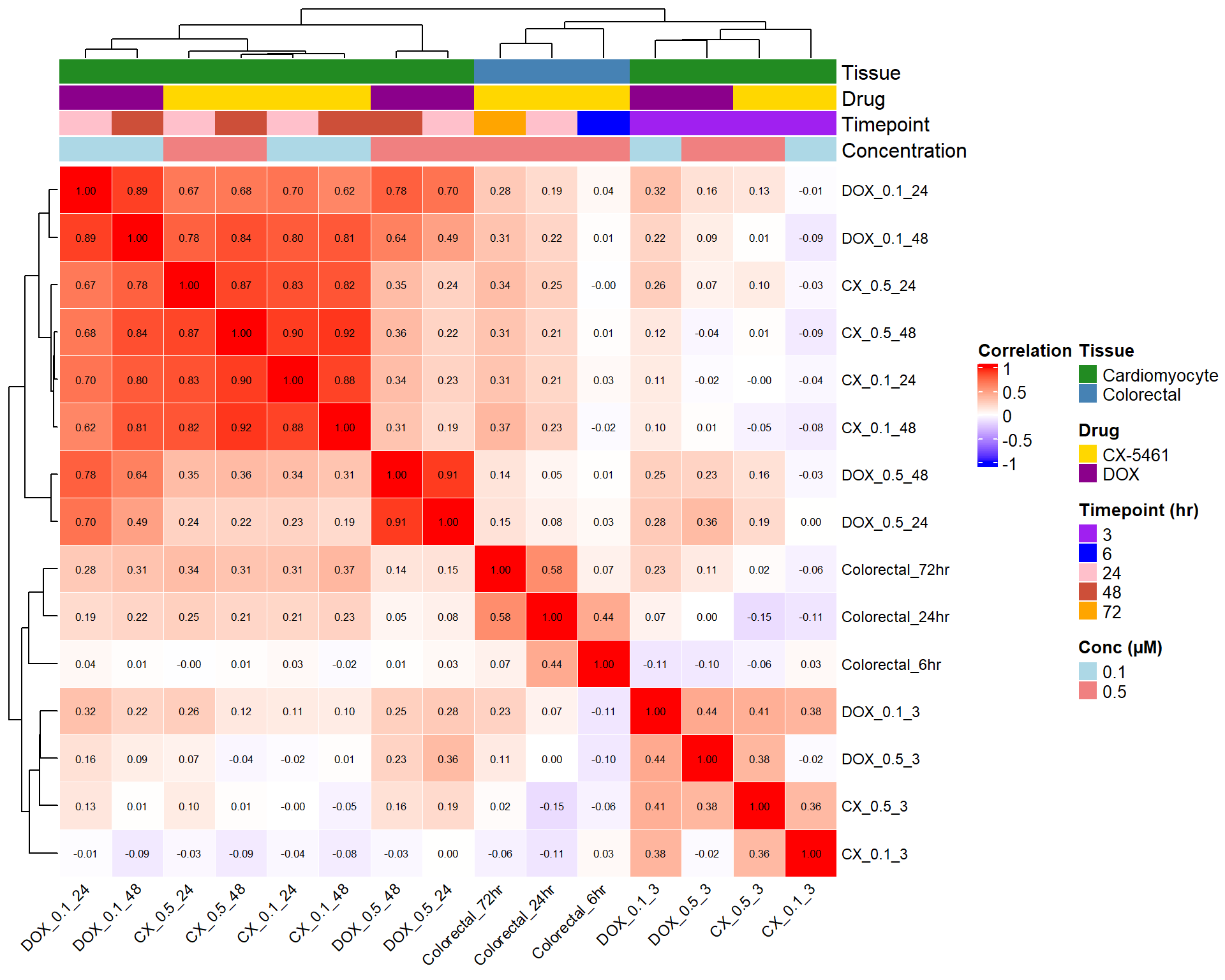
| Version | Author | Date |
|---|---|---|
| 488c5c4 | sayanpaul01 | 2025-06-02 |
sessionInfo()R version 4.3.0 (2023-04-21 ucrt)
Platform: x86_64-w64-mingw32/x64 (64-bit)
Running under: Windows 11 x64 (build 26100)
Matrix products: default
locale:
[1] LC_COLLATE=English_United States.utf8
[2] LC_CTYPE=English_United States.utf8
[3] LC_MONETARY=English_United States.utf8
[4] LC_NUMERIC=C
[5] LC_TIME=English_United States.utf8
time zone: America/Chicago
tzcode source: internal
attached base packages:
[1] grid stats4 stats graphics grDevices utils datasets
[8] methods base
other attached packages:
[1] RColorBrewer_1.1-3 circlize_0.4.16 ComplexHeatmap_2.18.0
[4] janitor_2.2.1 data.table_1.17.0 reshape2_1.4.4
[7] biomaRt_2.58.2 clusterProfiler_4.10.1 org.Hs.eg.db_3.18.0
[10] AnnotationDbi_1.64.1 IRanges_2.36.0 S4Vectors_0.40.2
[13] Biobase_2.62.0 BiocGenerics_0.48.1 lubridate_1.9.4
[16] forcats_1.0.0 stringr_1.5.1 dplyr_1.1.4
[19] purrr_1.0.4 readr_2.1.5 tidyr_1.3.1
[22] tibble_3.2.1 ggplot2_3.5.2 tidyverse_2.0.0
loaded via a namespace (and not attached):
[1] shape_1.4.6.1 rstudioapi_0.17.1 jsonlite_2.0.0
[4] magrittr_2.0.3 magick_2.8.6 farver_2.1.2
[7] rmarkdown_2.29 GlobalOptions_0.1.2 fs_1.6.3
[10] zlibbioc_1.48.2 vctrs_0.6.5 Cairo_1.6-2
[13] memoise_2.0.1 RCurl_1.98-1.17 ggtree_3.10.1
[16] htmltools_0.5.8.1 progress_1.2.3 curl_6.2.2
[19] gridGraphics_0.5-1 sass_0.4.10 bslib_0.9.0
[22] plyr_1.8.9 cachem_1.1.0 whisker_0.4.1
[25] igraph_2.1.4 iterators_1.0.14 lifecycle_1.0.4
[28] pkgconfig_2.0.3 Matrix_1.6-1.1 R6_2.6.1
[31] fastmap_1.2.0 gson_0.1.0 clue_0.3-66
[34] snakecase_0.11.1 GenomeInfoDbData_1.2.11 digest_0.6.34
[37] aplot_0.2.5 enrichplot_1.22.0 colorspace_2.1-0
[40] patchwork_1.3.0 rprojroot_2.0.4 RSQLite_2.3.9
[43] filelock_1.0.3 labeling_0.4.3 timechange_0.3.0
[46] mgcv_1.9-3 httr_1.4.7 polyclip_1.10-7
[49] compiler_4.3.0 doParallel_1.0.17 bit64_4.6.0-1
[52] withr_3.0.2 BiocParallel_1.36.0 viridis_0.6.5
[55] DBI_1.2.3 ggforce_0.4.2 MASS_7.3-60
[58] rappdirs_0.3.3 rjson_0.2.23 HDO.db_0.99.1
[61] tools_4.3.0 ape_5.8-1 scatterpie_0.2.4
[64] httpuv_1.6.15 glue_1.7.0 nlme_3.1-168
[67] GOSemSim_2.28.1 promises_1.3.2 shadowtext_0.1.4
[70] cluster_2.1.8.1 fgsea_1.28.0 generics_0.1.3
[73] gtable_0.3.6 tzdb_0.5.0 hms_1.1.3
[76] xml2_1.3.8 tidygraph_1.3.1 XVector_0.42.0
[79] foreach_1.5.2 ggrepel_0.9.6 pillar_1.10.2
[82] yulab.utils_0.2.0 later_1.3.2 splines_4.3.0
[85] tweenr_2.0.3 BiocFileCache_2.10.2 treeio_1.26.0
[88] lattice_0.22-7 bit_4.6.0 tidyselect_1.2.1
[91] GO.db_3.18.0 Biostrings_2.70.3 knitr_1.50
[94] git2r_0.36.2 gridExtra_2.3 xfun_0.52
[97] graphlayouts_1.2.2 matrixStats_1.5.0 stringi_1.8.3
[100] workflowr_1.7.1 lazyeval_0.2.2 ggfun_0.1.8
[103] yaml_2.3.10 evaluate_1.0.3 codetools_0.2-20
[106] ggraph_2.2.1 qvalue_2.34.0 ggplotify_0.1.2
[109] cli_3.6.1 munsell_0.5.1 jquerylib_0.1.4
[112] Rcpp_1.0.12 GenomeInfoDb_1.38.8 dbplyr_2.5.0
[115] png_0.1-8 XML_3.99-0.18 parallel_4.3.0
[118] blob_1.2.4 prettyunits_1.2.0 DOSE_3.28.2
[121] bitops_1.0-9 viridisLite_0.4.2 tidytree_0.4.6
[124] scales_1.3.0 crayon_1.5.3 GetoptLong_1.0.5
[127] rlang_1.1.3 cowplot_1.1.3 fastmatch_1.1-6
[130] KEGGREST_1.42.0